2013年《微生物学》实验双语测试题
微生物学与免疫学题(中英)
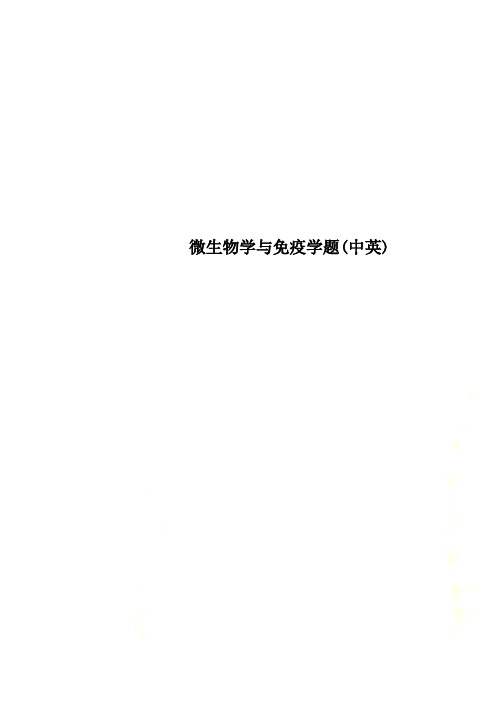
微生物学与免疫学题(中英)微生物学与免疫学复习题一、名词解释acquired Immune deficiency syndrome, AIDS(获得性免疫缺陷综合征,艾滋病) 由人类免疫缺陷病毒引起的传染病综合征,其特征为失去正常免疫应答,随后易感染机会性传染病和某些癌症。
acquired immunity(获得性免疫) 指特异性免疫类型,在与适当的抗原接触后或抗体从一个体转移到另一个体后产生。
active carrier(病期带菌者) 带有明显的临床病症和可能传播传染病给他人的个体。
active immunization(自动免疫接种) 通过自然接触病原体或接种疫苗诱发自动免疫。
active transport(主动运输) 溶液分子依电化学梯度跨膜的运输,这需要载体蛋白和能量的输入。
Active transport is the transport of solute molecules to higher concentrations, or against a concentration gradient, with the use of metabolic energy input.(2004A)adhesin(粘附素) 微生物表面的分子组分,参与对底物或细胞的粘附。
对特异性宿主组织的粘附通常是发病的预备阶段,而粘附素是重要的毒力因子。
Adherence is the process by which bacteria stick to the surfaces of host cells,Once bacteria have entered the body,adherence is major initial step in the infection process.The terms adherence,adhesion, and attachment are often used interchangeably(交替).adjuvant(佐剂) 加入抗原以提高其免疫原性的物质,常见的例子有明矾,灭活的百日咳菌和抗原的油乳剂,或者是单独使用(弗氏不完全佐剂),或者是与灭活的分枝杆菌一起使用(弗氏完全佐剂)。
微生物学检验练习题(附答案)
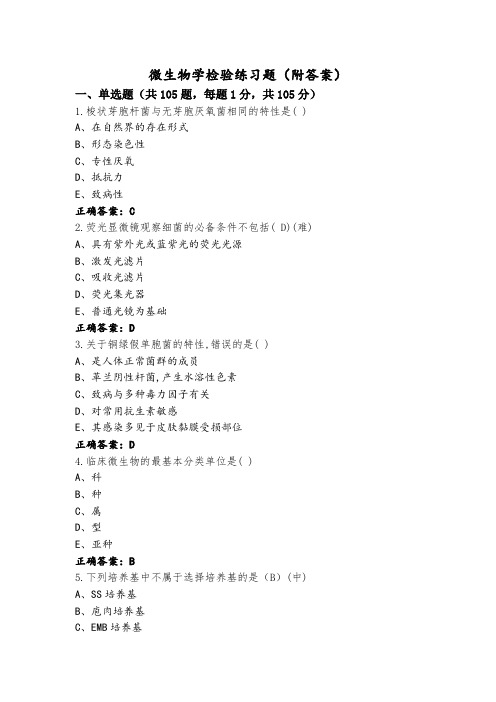
微生物学检验练习题(附答案)一、单选题(共105题,每题1分,共105分)1.梭状芽胞杆菌与无芽胞厌氧菌相同的特性是( )A、在自然界的存在形式B、形态染色性C、专性厌氧D、抵抗力E、致病性正确答案:C2.荧光显微镜观察细菌的必备条件不包括( D)(难)A、具有紫外光或蓝紫光的荧光光源B、激发光滤片C、吸收光滤片D、荧光集光器E、普通光镜为基础正确答案:D3.关于铜绿假单胞菌的特性,错误的是( )A、是人体正常菌群的成员B、革兰阴性杆菌,产生水溶性色素C、致病与多种毒力因子有关D、对常用抗生素敏感E、其感染多见于皮肤黏膜受损部位正确答案:D4.临床微生物的最基本分类单位是( )A、科B、种C、属D、型E、亚种正确答案:B5.下列培养基中不属于选择培养基的是(B)(中)A、SS培养基B、庖肉培养基C、EMB培养基D、高盐培养基E、罗一琴培养基正确答案:B6.物表和空气的消毒,宜选用的消毒方法是(E)(中)A、巴氏消毒法B、间歇灭菌法C、高压蒸气灭菌法D、流通蒸气灭菌法E、紫外线照射法正确答案:E7.甲基红试验中培养基的pH 需降至多少、指示剂才指示阳性结果(D)(难)A、7.4B、6.5C、5D、4.5E、2.5正确答案:D8.革兰染色法脱色时所用乙醇浓度为A、95%B、90%C、20%D、40%E、70%正确答案:A9.关于培养基的叙述,错误的是(B)(中)A、按物理性状分为三类B、物理性状相同的培养基,其用途相似C、不同的培养基其成分不尽相同D、按用途分为六类E、成分柜同的培养基,其物理性状也相同正确答案:B10.碳源和氮源利用试验不包括( )A、硝酸盐还原试验B、丙二酸盐利用试验C、马尿酸盐水解试验D、枸橼酸盐利用试验E、醋酸盐利用试验正确答案:A11.下列哪种物质是原核细胞型微生物所特有的化学成分(C)(中)A、脂质B、无机盐C、肽聚糖D、蛋白质E、几丁质正确答案:C12.青霉素对细菌的作用机制是(B)(难)A、切断β-1,4 糖苷键B、干扰四肽侧链与五肽交联桥的连接C、影响细胞膜的合成D、干扰磷壁酸的活性E、干扰细菌DNA 的复制正确答案:B13.肺炎链球菌在血平板上生长时,菌落周围常会出现溶血环,其特征为( )A、褐色B、黄色C、砖红色D、暗红色E、草绿色正确答案:E14.真菌的繁殖结构就是:( )A、始体B、孢子C、原体D、包涵体E、芽孢正确答案:B15.细菌染色过程中固定的作用主要是(C)(中)A、使其易与染料结合B、使其失去抗原性C、杀死细菌D、利于保存E、破坏细菌结构正确答案:C16.甲基红试验所用培养基是(D)(难)A、肉汤培养基B、蛋白胨水C、碱性蛋白胨水D、葡萄糖蛋白胨水E、生理盐水正确答案:D17.关于脂多糖的叙述哪项是不正确的( )A、由磷脂和脂蛋白组成B、可称为细菌内毒素C、存在于革兰阴性菌的外膜D、由脂类和多糖组成E、具有多种生物学活性正确答案:A18.鹅口疮的病原菌就是:( )A、螺旋体B、立克次体C、细菌D、衣原体E、真菌正确答案:E19.尿液标本作L型菌培养时,培养基中加入20%蔗糖的原因是( )A、稀释尿液B、使尿中蛋白质变性C、中和尿液的酸度D、提供高营养E、保持高渗环境正确答案:E20.经螨传播的立克次体病是( )A、流行性斑疹伤寒B、恙虫病C、地方性斑疹伤寒D、落矶山斑点热E、Q热正确答案:B21.关于细菌产生的色素,错误的是( )A、有助于鉴别细菌B、可进行光合作用C、分两类:脂溶性和水溶性D、色素产生需一定的条件E、其功能尚不清楚正确答案:B22.和耶尔森菌属属于同科的细菌是( )A、链球菌B、棒状杆菌C、志贺菌D、奈瑟菌E、鲍特菌正确答案:C23.在一般中性环境中细菌带负电荷,易与以下何种染料结合(D)(中)A、中性染料B、姬姆萨染料C、酸性染料D、碱性染料E、以上均不对正确答案:D24.属于营养培养基的是(A)(中)A、巧克力平板B、SS平板C、麦康凯平板D、碱性蛋白胨水E、伊红一美蓝琼脂正确答案:A25.沙门菌属在普通平板上的菌落特征是(E)A、中等大小,粗糙型B、针尖状小菌落,半透明C、中等大小,粘液型D、针尖状小菌落,粘液型E、中等大小,无色半透明正确答案:E26.副溶血弧菌在TCBS平板上的菌落为( )A、红色B、黄色C、绿色D、蓝色E、黑色正确答案:C27.非发酵菌包括( )A、假单胞菌属,黄杆菌属,变形杆菌属B、假单胞菌属,埃希菌属,产碱杆菌属C、莫拉菌属,黄杆菌属,肠杆菌属D、假单胞菌属,不动杆菌属,产碱杆菌属E、假单胞菌属,气单胞菌属,黄杆菌属正确答案:D28.不同来源的同种细菌称为A、种B、菌株C、型D、异种E、亚种正确答案:B29.甲基红试验中培养基的pH需降至多少,指示剂才指示阳性结果(C)(难)A、2.5B、5.OC、4.5D、6.5E、7.4正确答案:C30.关于菌毛的叙述,下列哪项是错误的(C)(中)A、多见于革兰阴性菌B、有普通菌毛和性菌毛两种C、能直接用光学显微镜观察D、性菌毛与细菌的接合有关E、普通菌毛与性菌毛的致病力有关正确答案:C31.注射前在局部用碘酒和乙醇处理属于A、无菌操作B、灭菌C、消毒D、防腐E、无菌正确答案:C32.不动杆菌属细菌引起的院内感染,最常见的部位是( )A、泌尿道B、消化道C、呼吸道D、生殖道E、皮肤伤口正确答案:C33.在细菌检验中,制备血平板最常用血液采自(C)(中)A、豚鼠B、家兔C、绵羊D、大白鼠E、马正确答案:C34.细菌代谢活动活跃的原因是()。
微生物学检验测试题与答案
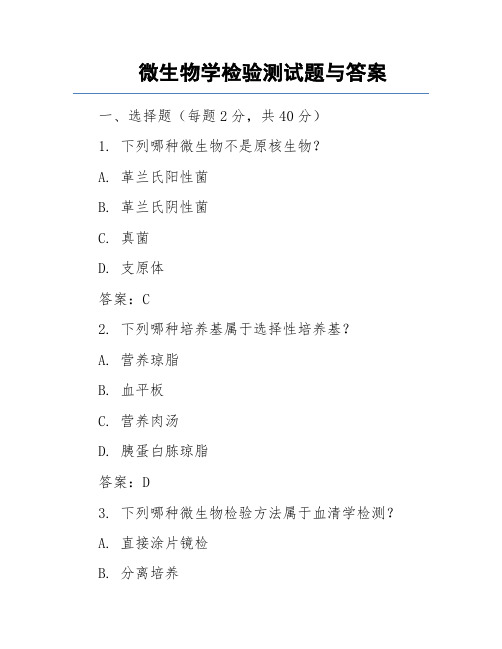
微生物学检验测试题与答案一、选择题(每题2分,共40分)1. 下列哪种微生物不是原核生物?A. 革兰氏阳性菌B. 革兰氏阴性菌C. 真菌D. 支原体答案:C2. 下列哪种培养基属于选择性培养基?A. 营养琼脂B. 血平板C. 营养肉汤D. 胰蛋白胨琼脂答案:D3. 下列哪种微生物检验方法属于血清学检测?A. 直接涂片镜检B. 分离培养C. 聚合酶链反应D. 酶联免疫吸附试验答案:D4. 下列哪种微生物具有芽孢结构?A. 芽孢杆菌B. 梭菌C. 链球菌D. 肠道杆菌答案:A5. 下列哪种抗生素属于青霉素类?A. 阿莫西林B. 头孢菌素C. 红霉素D. 庆大霉素答案:A6. 下列哪种微生物检验方法可以用于检测细菌耐药性?A. 纸片扩散法B. 琼脂稀释法C. E测试D. 所有以上方法答案:D7. 下列哪种微生物可以引起医院感染?A. 金黄色葡萄球菌B. 大肠杆菌C. 肺炎克雷伯菌D. 所有以上微生物答案:D8. 下列哪种微生物检验方法属于分子生物学检测?A. 直接涂片镜检B. 分离培养C. 聚合酶链反应D. 酶联免疫吸附试验答案:C9. 下列哪种微生物可以引起食物中毒?A. 沙门氏菌B. 志贺氏菌C. 霍乱弧菌D. 所有以上微生物答案:D10. 下列哪种微生物可以引起败血症?A. 金黄色葡萄球菌B. 大肠杆菌C. 链球菌D. 所有以上微生物答案:D二、填空题(每题2分,共20分)1. 微生物的分类主要包括______、______、______三大类。
答案:原核生物、真核生物、非细胞型微生物2. 培养基按其物理状态可分为______、______、______三种类型。
答案:液体培养基、半固体培养基、固体培养基3. 微生物检验的四大基本技术包括______、______、______、______。
答案:形态学检查、生理生化试验、血清学检测、分子生物学检测4. 细菌耐药性检测方法有______、______、______等。
微生物测试题(附答案)
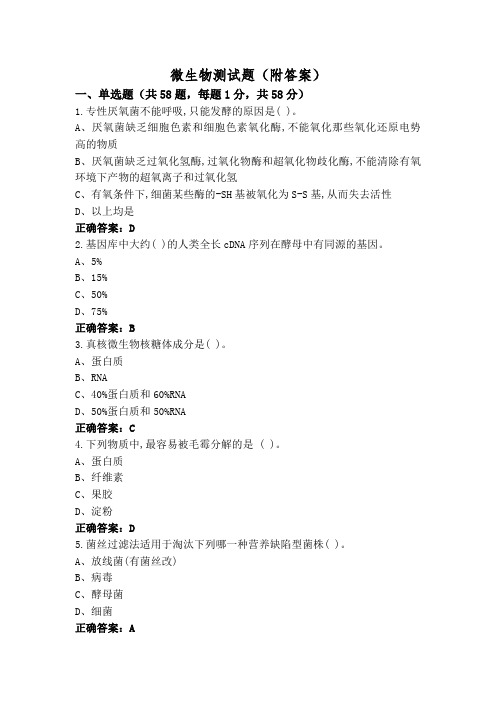
微生物测试题(附答案)一、单选题(共58题,每题1分,共58分)1.专性厌氧菌不能呼吸,只能发酵的原因是( )。
A、厌氧菌缺乏细胞色素和细胞色素氧化酶,不能氧化那些氧化还原电势高的物质B、厌氧菌缺乏过氧化氢酶,过氧化物酶和超氧化物歧化酶,不能清除有氧环境下产物的超氧离子和过氧化氢C、有氧条件下,细菌某些酶的-SH基被氧化为S-S基,从而失去活性D、以上均是正确答案:D2.基因库中大约( )的人类全长cDNA序列在酵母中有同源的基因。
A、5%B、15%C、50%D、75%正确答案:B3.真核微生物核糖体成分是( )。
A、蛋白质B、RNAC、40%蛋白质和60%RNAD、50%蛋白质和50%RNA正确答案:C4.下列物质中,最容易被毛霉分解的是 ( )。
A、蛋白质B、纤维素C、果胶D、淀粉正确答案:D5.菌丝过滤法适用于淘汰下列哪一种营养缺陷型菌株( )。
A、放线菌(有菌丝改)B、病毒C、酵母菌D、细菌正确答案:A6.真菌的营养方式为( )。
A、异养吸收型B、自给自足型C、化能自养型D、光能自养型正确答案:A7.能够高效进行自发转化的细菌是 ( )。
A、固氮菌B、链球菌C、奢血菌D、以上均是正确答案:D8.核苷酸在生物体内的作用,以下说法正确的是( )A、只能合成核酸和参与某些酶的组成B、只能参与某些酶的组成C、只能合成核酸D、主要是合成核酸和参与某些酶的组成正确答案:D9.真核微生物核糖体的功能是( )。
A、合成糖类物质B、进行氧化磷酸化反应C、合成蛋白质D、合成脂类物质正确答案:C10.微生物生态系统自身的特点不包括 ( )。
A、协调性B、适应性C、微环境D、稳定性正确答案:A11.关于氮源的描述,以下说法错误的是( )A、主要功能是提供合成原生质和细胞结构成分的氮素来源B、不提供能量(ATP中的含氮碱基C、来源最广的是分子态氮D、硝化细菌可以利用氮源提供能量正确答案:B12.关于微生物代谢调节的叙述,错误的是( )A、组成酶的合成只受遗传物质的控制,与生长环境中的营养物质无关B、微生物代谢调节主要有酶合成调节和酶活性调节C、在酶活性调节过程中,代谢产物与酶结合,能使酶分子结构和或许产生可逆变化D、酶合成调节是一种快速、精细的调节方式正确答案:A13.培养基中使用牛肉膏的作用是为微生物提供( )A、C源B、N源C、生长因素D、A,B,C都提供正确答案:D14.病毒、细菌和真菌个体的直径比约为( )。
微生物学检验习题库与参考答案

微生物学检验习题库与参考答案一、单选题(共105题,每题1分,共105分)1.菌毛可用下列哪种显微镜观察A、荧光显微镜B、普通光学显微镜C、电子显微镜D、暗视野显微镜E、相差显微镜正确答案:C2.细菌的革兰染色性不同是由于( )A、细胞膜结构的不同B、细胞核结构的不同C、中介体的有无.D、胞质颗粒的有无或不同E、细胞壁结构的不同正确答案:E3.在一般中性环境中细菌带负电荷,易与以下何种染料结合( )A、中性染料B、姬姆萨染料C、酸性染料D、碱性染料E、以上均不对正确答案:D4.关于细菌产生的色素,错误的是( )A、有助于鉴别细菌B、可进行光合作用C、分两类:脂溶性和水溶性D、色素产生需一定的条件E、其功能尚不清楚F、大多由革兰阳性菌合成G、细菌生长繁殖过程中即可释放出来H、抗原性弱正确答案:C5.细菌的特殊结构不包括B、鞭毛C、荚膜D、芽胞E、中介体正确答案:E6.支原体与细菌L型的相同点是(C)A、都不能在无细胞的人工培养基上生长B、都是分支繁殖C、无细胞壁D、遗传物质都是RNAE、形态一致正确答案:C7.某患者因腹痛,腹泻入院,自叙有乏力,里急后重。
检查见其大便为水样便、无脓血,但体温正常,亦无脱水和呕吐,肝功能亦正常。
取粪便粘液部分镜检可见大量红细胞及白细胞,此患者应考虑是(C)A、肠炎型沙门菌感染B、轻型细菌性痢疾C、大肠埃希菌性肠炎D、阿米巴性痢疾E、霍乱正确答案:C8.青霉素对细菌的作用机制是(B)(难)A、切断β-1,4 糖苷键B、干扰四肽侧链与五肽交联桥的连接C、影响细胞膜的合成D、干扰磷壁酸的活性E、干扰细菌DNA 的复制正确答案:B9.触酶是(B)(易)A、氧化酶B、过氧化氢酶C、细胞色素氧化酶D、超氧化物歧化酶正确答案:B10.下列物质与细菌侵袭力无关是(D)(中)A、溶血素B、菌毛C、透明质酸酶D、芽胞E、荚膜正确答案:D11.实验室诊断皮肤癣菌感染时,皮屑或病发须经哪种溶液处理后再镜检:( )A、10%NaclB、70%乙醇C、10%KOHD、25%KOHE、15%NAOH正确答案:C12.关于细菌产生的色素,错误的是( )A、有助于鉴别细菌B、可进行光合作用C、分两类:脂溶性和水溶性D、色素产生需一定的条件E、其功能尚不清楚正确答案:B13.G+菌和G-菌细胞壁共同成分或结构是A、脂多糖B、磷壁酸C、外膜D、肽聚糖E、以上均不是正确答案:D14.细菌毒素中,毒性最强的是(D)(易)A、破伤风痉挛毒素B、金葡菌肠毒素C、白喉外毒素D、肉毒毒素E、霍乱肠毒素正确答案:D15.细菌合成细胞组分和获得能量的基质主要是( )A、糖原B、脂类C、淀粉D、蛋白质E、糖类正确答案:E16.绝大多数微生物对人类和动植物是A、可有可无的B、病原菌C、引起内源性感染D、有益的E、有害的正确答案:D17.从有正常菌群存在的部位所采取的标本应接种在哪种培养基中分离培养病原体( D)(易)A、基础培养基B、营养培养基C、增菌培养基D、选择鉴别培养基E、特殊培养基正确答案:D18.下列有关药敏试验意义的论述,错误的一项是A、药敏试验可预测抗菌治疗的效果B、药敏试验结果为“敏感”时,治疗可能有效C、药敏试验结果是提供药物选择的依据D、药敏试验为中介时,只要加大药物剂量完全可以达到治疗效果E、体外药敏结果不完全与体内治疗效果一致正确答案:D19.利用细菌生化反应鉴定细菌是根据(D)(难)A、细菌酶活性差异B、细菌毒素活性差异C、细菌酶含量的差异D、细菌分解代谢产物的差异E、细菌毒素种类的差异正确答案:D20.胆汁溶菌试验常用于鉴别A、A群链球菌与B群链球菌B、A群链球菌与D群链球菌C、肺炎链球菌和甲型溶血型链球菌D、肺炎链球菌和乙型溶血型链球菌E、表皮葡萄球菌与腐生葡萄球菌正确答案:C21.下列物质与细菌侵袭力无关是( )A、菌毛B、荚膜C、溶血素D、透明质酸酶E、芽胞正确答案:E22.细菌的革兰染色性不同是由于(C)(中)A、细胞核结构的不同B、细胞膜结构的不同C、细胞壁结构的不同D、中介体的有无.E、胞质颗粒的有无或不同正确答案:C23.气相色谱仪鉴定厌氧菌是检测(E)(难)A、细菌的抗原物质B、细菌的核酸C、细菌的酶活性D、细菌的化学组成E、细菌的代谢产物正确答案:E24.对厌氧条件要求不严格的细菌是( )A、双歧杆菌B、产黑色素类普雷沃菌C、艰难梭菌D、产气荚膜梭菌E、破伤风梭菌正确答案:D25.下列对外毒素的描述哪项是正确的(C)(中)A、对器官组织的毒性作用无选择性B、毒性作用弱C、大多数外毒素是在菌体内合成后分泌至菌体外D、多数耐热E、外毒素大都由革兰阴性菌产生正确答案:C26.下列哪种细菌不是革兰氏阴性菌( )A、伤寒沙门菌B、霍乱弧菌C、铜绿假单胞菌D、大肠埃希菌E、结核分枝杆菌正确答案:E27.血培养时采血量一般为血培养瓶中肉汤培养基量的A、1/4~1/3B、1/5~1/4C、1/7~1/6D、1/6~1/5E、1/3~1/ 2正确答案:B28.通常用于结核分枝杆菌分离培养的痰液,预处理时常用的消化液是( )A、4%NaOHB、3%NaOHC、3%KOHD、2%KOHE、0.5%NaOH正确答案:A29.关于液体培养接种,错误的是(C)(中)A、用手斜持液体培养基管B、根据接种物性质,可选用接种针或接种环C、在与液面交接处的管壁上轻轻研磨,并沾取少许培养基液体调和D、无菌操作关闭试管,直立培养E、有细菌生长时,培养管可呈现混浊、沉淀和菌膜等现象正确答案:C30.细菌哪种结构的功能类似真核细胞的线粒体(C)(难)A、核蛋白体B、胞质颗粒C、中介体D、质粒E、异染颗粒正确答案:C31.下列细菌特殊结构中,具有较强抵抗力的是A、荚膜B、鞭毛C、性菌毛D、芽胞E、菌毛正确答案:D32.下面有关细菌的命名说法错误的是A、细菌种的命名采用拉丁文双命名法B、由两个拉丁字组成C、前一字为属名D、中文译名的属名放在前面E、后一字为种名正确答案:D33.用萋内抗酸染色法,结果呈阳性的菌体是(E)(易)A、黄色B、紫色C、蓝色D、绿色E、红色正确答案:E34.能使纤维蛋白凝块溶解的是A、链激酶B、磷脂酶C、胶原酶D、透明质酸酶E、血浆凝固酶正确答案:A35.A群链球菌与其他群链球菌的主要鉴别试验是(B)(易)A、血浆凝固酶试验B、杆菌肽敏感试验C、马尿酸水解试验D、甘露醇发酵试验E、新生霉素敏感试验正确答案:B36.革兰染色所用染液的顺序是( )A、稀释复红一碘液一酒精一结晶紫B、结晶紫一碘液一酒精一稀释复红C、结晶紫一酒精一碘液一稀释复红D、稀释复红一酒精一结晶紫一碘液E、稀释复红一结晶紫一碘液一酒精正确答案:B37.G‐菌内毒素成分是A、肽聚糖B、磷壁酸C、脂质AD、外膜蛋白E、DAP正确答案:C38.有关外毒素的错误描述是(D)(难)A、主要由革兰阳性菌产生B、也可由革兰阴性菌产生C、具有特异的组织亲和性D、其成分为脂多糖E、可经甲醛脱毒成类毒素正确答案:D39.使用比浊法可粗略估计细菌的数量与下列何种物理性状有关A、光学性质B、带电现象C、半渗透性D、渗透压E、表面积正确答案:A40.经螨传播的立克次体病是( )A、恙虫病B、落矶山斑点热C、地方性斑疹伤寒D、Q热E、流行性斑疹伤寒正确答案:A41.自动化微生物药敏系统进行药敏测的实质是A、K-B纸片扩散法B、微量肉汤稀释法C、琼脂稀释法D、联合药敏试验E、E-test法正确答案:B42.下列哪种细菌不会引起食物中毒( )A、鼠伤寒沙门菌B、痢疾志贺菌C、丙型副伤寒杆菌D、产肠毒素的金葡菌E、蜡样芽胞杆菌正确答案:B43.革兰阳性菌和革兰阴性菌细胞壁的共同成分是(D)(易)A、磷壁酸B、脂多糖C、脂蛋白D、肽聚糖E、脂质正确答案:D44.观察螺旋体最好的方法是( )A、抗酸染色法B、Giemsa染色法C、直接镜检D、暗视野显微镜法E、革兰氏染色法正确答案:D45.D群链球菌的重要特征是(C)(易)A、对杆菌肽耐药B、对杆菌肽敏感C、胆汁七叶苷试验阳性D、水解尿酸E、CAMP 试验阳性正确答案:C46.金黄色葡萄球菌与表皮葡萄球菌的主要鉴别试验是(C)(易)A、VP试验B、吲哚试验C、凝固酶试验D、触酶试验E、O/F试验正确答案:C47.KIA琼脂一般不用于观察( )A、乳糖发酵B、硫化氢产生C、葡萄糖发酵D、色氨酸E、产气试验正确答案:D48.细菌染色多采用的染料是(C)(中)A、酸性染料B、中性染料C、碱性染料D、复合染料E、单纯染料正确答案:C49.不属于细菌菌落特征的是(D)(易)A、湿润B、扁平C、完全溶血D、致密E、透明正确答案:D50.构成细菌毒力的是(B)(中)A、基本结构B、侵袭力和毒素C、特殊结构D、分解代谢产物E、侵入机体的途径·正确答案:B51.测量细菌大小的单位是( )A、dmB、cmC、μmD、mmE、nm正确答案:C52.抗生素使用不当可导致(D)(中)A、十二指肠溃疡B、肠结核C、慢性胃炎D、伪膜性肠炎E、腹膜炎正确答案:D53.某村,春节后有3名散居儿童在l周内先后突然出现发热、头痛、喷射状呕吐、全身满布皮肤出血点、颈项强直明显。
微生物实验课试题库及标准答案
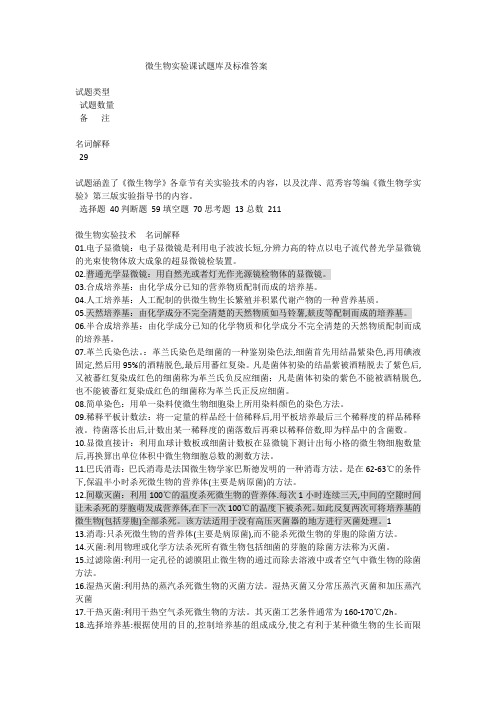
微生物实验课试题库及标准答案试题类型试题数量备注名词解释29试题涵盖了《微生物学》各章节有关实验技术的内容,以及沈萍、范秀容等编《微生物学实验》第三版实验指导书的内容。
选择题40判断题59填空题70思考题13总数211微生物实验技术名词解释01.电子显微镜:电子显微镜是利用电子波波长短,分辨力高的特点以电子流代替光学显微镜的光束使物体放大成象的超显微镜检装置。
02.普通光学显微镜:用自然光或者灯光作光源镜检物体的显微镜。
03.合成培养基:由化学成分已知的营养物质配制而成的培养基。
04.人工培养基:人工配制的供微生物生长繁殖并积累代谢产物的一种营养基质。
05.天然培养基:由化学成分不完全清楚的天然物质如马铃薯,麸皮等配制而成的培养基。
06.半合成培养基:由化学成分已知的化学物质和化学成分不完全清楚的天然物质配制而成的培养基。
07.革兰氏染色法。
:革兰氏染色是细菌的一种鉴别染色法,细菌首先用结晶紫染色,再用碘液固定,然后用95%的酒精脱色,最后用蕃红复染。
凡是菌体初染的结晶紫被酒精脱去了紫色后,又被蕃红复染成红色的细菌称为革兰氏负反应细菌;凡是菌体初染的紫色不能被酒精脱色,也不能被蕃红复染成红色的细菌称为革兰氏正反应细菌。
08.简单染色:用单一染料使微生物细胞染上所用染料颜色的染色方法。
09.稀释平板计数法:将一定量的样品经十倍稀释后,用平板培养最后三个稀释度的样品稀释液。
待菌落长出后,计数出某一稀释度的菌落数后再乘以稀释倍数,即为样品中的含菌数。
10.显微直接计:利用血球计数板或细菌计数板在显微镜下测计出每小格的微生物细胞数量后,再换算出单位体积中微生物细胞总数的测数方法。
11.巴氏消毒:巴氏消毒是法国微生物学家巴斯德发明的一种消毒方法。
是在62-63℃的条件下,保温半小时杀死微生物的营养体(主要是病原菌)的方法。
12.间歇灭菌:利用100℃的温度杀死微生物的营养体.每次1小时连续三天,中间的空隙时间让未杀死的芽胞萌发成营养体,在下一次100℃的温度下被杀死。
微生物学英文题库完整

IntroductionMicrobes are a diverse group of organisms that can be divided into the viruses, unicellular groups (Archaea, Eubacteria, protista, some fungi and some chlorophyta) and a small number of organisms with a simple multicellular structure (the large fungi and chlorophyta).Microbiology: the science (logos) of small (micro) life (bios). The study of living things so small that they cannot be seen with the naked eye.The three-domain system is a biological classification introduced by Carl Woese that divides cellular life forms into archaea, bacteria, and eukaryote domains. In particular, it emphasizes the separation of prokaryotes into two groups, originally called Eubacteria (now Bacteria) and Archaebacteria (now Archaea).Microorganisms were first visualized by Antoni van Leeuwenhoek (1632–1723), a Dutch cloth merchant and an expert lens grinder.The first proof of the involvement of bacteria in disease and the definitive proof of the germ theory of disease came from the German Robert Koch.Koch’s po stulates:1, The microorganism must be present in every instance of the disease and absent from healthy individuals.2, The microorganism must be capable of being isolated and grown in pure culture.3 ,When the microorganism is inoculated into a healthy host, the same disease condition must result.4, The same microorganism must be re-isolated from the experimentally infected host. Chapter oneFungi include yeasts, molds, and mushrooms.Viruses are noncellular organisms; they are intra-cellular parasites of animals, plants, or bacteria.1, The Prokaryotes can be divided into two kingdoms, Bacteria and Archaea. The classification was first proposed by Woese based on the differences in 16S rRNA sequence.2, Prokaryotic microorganism(原核微生物): It is an single-c elled organism which doesn’t have a nuclear membrane outside the cell nucleus and only has the bare DNA called as the nuclear area. 3, Many bacteria are shaped like long rods twisted into spirals or helices; they are called spirilla (螺旋菌)if rigid and spirochetes (螺旋体) when flexible.4, Capsules (荚膜) and slime layers (粘液层) usually are composed of polysaccharides (多糖), but they may be constructed of other materials.5, Gram staining procedure(革兰氏染色的步骤)In the first step of the Gram-staining procedure, the smear is stained with the basic dye crystal violet, the primary stain. It is followed by treatment with an iodine solution functioning as a mordant. That is, the iodine increases the interaction between the cell and the dye so that the cell is stained more strongly. The smear is next decolorized by washing with ethanol or acetone. This step generates the differential aspect of the Gram stain; gram-positive bacteria retain the crystal violet, whereas gram-negative bacteria lose their crystal violet and become colorless. Finally, the smear is counterstained with a simple, basic dye different in color from crystal violet. Safranin, the most common counterstain, colors gram-negative bacteria pink to red and leaves gram-positive bacteria dark purple.6, The Mechanism of Gram Staining (革兰氏染色的机制)Although several explanations have been given for the Gramstain reaction results, it seems likely that the difference between gram-positive and gram-negative bacteria is due to the physical nature of their cell walls. If the cell wall is removed from grampositive bacteria, they become gram negative. The peptidoglycan itself is not stained; instead it seems to act as a permeability barrier preventing loss of crystal violet. During the procedure the bacteria are first stained with crystal violet and next treated with iodine to promote dye retention. When gram-positive bacteria then are decolorized with ethanol, the alcohol is thought to shrink the pores of the thick peptidoglycan. Thus the dye-iodine complex is retained during the short decolorization step and the bacteria remain purple. In contrast, gram-negative peptidoglycan is very thin, not as highly cross-linked, and has larger pores. Alcohol treatment also may extract enough lipid from the gramnegative wall to increase its porosity further. For these reasons, alcohol more readily removes the purple crystal violet-iodine complex from gram-negative bacteria.简而言之,不同细菌的染色差异(G+或G-)是由于细胞壁化学成分的差异而引起了物理特性(脱色能力)的不同。
微生物学实验考试试题
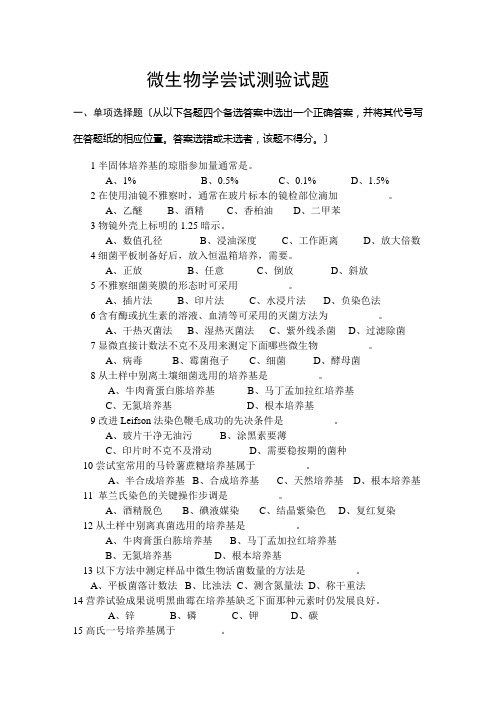
微生物学尝试测验试题一、单项选择题〔从以下各题四个备选答案中选出一个正确答案,并将其代号写在答题纸的相应位置。
答案选错或未选者,该题不得分。
〕1半固体培养基的琼脂参加量通常是。
A、1%B、0.5%C、0.1%D、1.5%2在使用油镜不雅察时,通常在玻片标本的镜检部位滴加__________。
A、乙醚B、酒精C、香柏油D、二甲苯3物镜外壳上标明的1.25暗示。
A、数值孔径B、浸油深度C、工作距离D、放大倍数4细菌平板制备好后,放入恒温箱培养,需要。
A、正放B、任意C、倒放D、斜放5不雅察细菌荚膜的形态时可采用__________。
A、插片法B、印片法C、水浸片法D、负染色法6含有酶或抗生素的溶液、血清等可采用的灭菌方法为__________。
A、干热灭菌法B、湿热灭菌法C、紫外线杀菌D、过滤除菌7显微直接计数法不克不及用来测定下面哪些微生物__________。
A、病毒B、霉菌孢子C、细菌D、酵母菌8从土样中别离土壤细菌选用的培养基是__________。
A、牛肉膏蛋白胨培养基B、马丁孟加拉红培养基C、无氮培养基D、根本培养基9改进Leifson法染色鞭毛成功的先决条件是__________。
A、玻片干净无油污B、涂黑素要薄C、印片时不克不及滑动D、需要稳按期的菌种10尝试室常用的马铃薯蔗糖培养基属于__________。
A、半合成培养基B、合成培养基C、天然培养基D、根本培养基11 革兰氏染色的关键操作步调是__________。
A、酒精脱色B、碘液媒染C、结晶紫染色D、复红复染12从土样中别离真菌选用的培养基是__________。
A、牛肉膏蛋白胨培养基B、马丁孟加拉红培养基B、无氮培养基D、根本培养基13以下方法中测定样品中微生物活菌数量的方法是__________。
A、平板菌落计数法B、比浊法C、测含氮量法D、称干重法14营养试验成果说明黑曲霉在培养基缺乏下面那种元素时仍发展良好。
A、锌B、磷C、钾D、碳15高氏一号培养基属于_________。
微生物实验课试题库及标准答案

微生物实验课试题库及标准答案以下是为大家整理的微生物实验课试题库及标准答案的相关范文,本文关键词为微生物,实验课,试题库,标准,答案,微生物学,实验,试题库,,您可以从右上方搜索框检索更多相关文章,如果您觉得有用,请继续关注我们并推荐给您的好友,您可以在综合文库中查看更多范文。
微生物学实验试题库及标准答案微生物实验课试题库及标准答案选择题01.革兰氏染色的关键操作步骤是:A.结晶紫染色。
b.碘液固定。
c.酒精脱色。
D.复染。
答:(c)02.放线菌印片染色的关键操作是:A.印片时不能移动。
b.染色。
c.染色后不能吸干。
D.A-c。
答:(A)。
03.高氏培养基用来培养:A.细菌。
b.真菌。
c.放线菌。
答:(c)。
04.肉汤培养基用来培养:A.酵母菌。
b.霉菌。
c.细菌。
答:(c)。
05.无氮培养基用来培养:A.自生固氮菌。
b.硅酸盐细菌。
c.根瘤菌。
D.A,b均可培养。
e.A,b,c均可培养。
答:(D)。
06.在使用显微镜油镜时,为了提高分辨力,通常在镜头和盖玻片之间滴加:A.二甲苯。
b.水。
c.香柏油。
答:(c)。
07.常用的消毒酒精浓度为:弋阳整理A.75%。
b.50%。
c.90%。
答:(A)。
08.用甲醛进行空气熏蒸消毒的用量是:3A.20ml/m。
3b.6ml/m。
3c.1ml/m。
答:(b)。
09.高压蒸汽灭菌的工艺条件是:A.121℃/30min。
.b.115℃/30min。
c.130℃/30min。
答:(A)。
10.巴氏消毒的工艺条件是:A.62-63℃/30min。
b.71-72℃/15min。
c.A.b.均可。
答:(c)。
11.半固体培养基的主要用途是:A.检查细菌的运动性。
b.检查细菌的好氧性。
c.A.b.两项。
答:(c)。
12.半固体培养基的琼脂加入量通常是:A.1%。
b.0.5%。
c.0.1%。
答:(b)。
13.使用手提式灭菌锅灭菌的关键操作是:A.排冷气彻底。
b.保温时间适当。
微生物期末英文习题答案

微生物期末英文习题答案一、CHOICE QUESTIONS:(20 Cent)1. Catabolism is a form of metabolism in which ___ molecules are converted into ___molecules.a. large, small c. amino acid, proteinb. small, large d. food, storage 2. A microbicidal agent has what effect?a. sterilizesb. inhibits microorganismsc. is toxic to human cellsd. destroys microorganisms3. Environmental factors such as temperature and pH exert their effect on the ___ ofmicrobial cells.a. membranes c. enzymesb. DNA d. cell wall 4. In general , fungi derive nutrients througha. photosynthesis c. digesting organic substratesb. engulfing bacteria d. parasitism 5. Both flagella and cilia are found primarily in__a. algae c. fungib. protozoa d. both b and c6. Which of the following is not found in all bacterial cells ?a. cell membrane c. ribosomesb. a nucleoid d. capsule7. Pili are tubular shafts in ___bacteria that serve as a means of___.a. gram-positive, genetic exchangeb. gram-positive, attachmentc. gram-negative, genetic exchanged. gram-negative, protection8. Which of the following is a primary bacteria cell wall function ?a. transport c. supportb. motility d. adhesion 9. A bacterial arrangement in packets of eight cells is described as a __ .a. micrococcus c. tetradb. diplococcus d.sarcina10. Genetic analysis of bacteria would includea. fermentation testingb. ability to digest complex nutrientsc. presence of oxidased. G+C content11. In general, if two haploid cells fuse , __will result .a. a germ cell c. mitosisb. a diploid zygote d. meiosis12. What is embedded in rough endoplasmic reticulum ?a. ribosomes c. chromatinb. Golgi apparatus d. vesicles 13. In general , fungi derive nutrients througha. photosynthesis c. digesting organic substratesb. engulfing bacteria d. parasitism 14. An organism that can synthesize all its required organic components from CO 2using energy from the sun is aa. photoautotroph c. chemoautotrophb. photoheterotroph d. chemoheterotroph 15. An obligate halophile higha. pH c. saltb. temperature d. pressure 16. Catabolism is a form of metabolism in which ___ molecules are converted into___ molecules.a. large, small c. amino acid, proteinb. small, large d. food, storage 17. An enzymea. becomes part of the final productsb. is nonspecific for substratec. is consumed by the reactiond. is heat and pH labile18. Many coenzymes area. metals c. proteinsb. vitamins d. substrates19. The temperature-pressure combination for an autoclave isa. 100? and 4 psi c. 131? and 9 psib. 121? and 15 psi d. 115? and 3 psi20. The most versatile methods of sterilizing heat-sensitive liquids isa. UV radiation c. beta propiolactoneb. exposure d. filtration二、Fill a vacancy:(15 Cents)1. The major locomotor structures in bacteria are flagella .2. A conidium is a/an ___ asexal spore , and a zygospore isa/an__ sexal _ spore .3. An organic nutrient essential to an organism’s metabolism that cannot besynthesized itself is termed a/an growth factor .4. Active transport of a substance across a membrane requires ATP .5. Superoxide ion is toxic to strict anaerobes because they lack catalase .6. During the __ stationary phase, the rate of new cells being added to thepopulation has slowed down.7. Complete oxidation of glucose in aerobic respiration yields a net output of 38_ ATP.8. Microorganisms have two fundamentally different types of cells-Prokaryotes andEucaryote —and are distributed among several kingdoms or domains.9. Koch developed the techniques required to grow bacteria on solid media and to isolate pure cultures of pathogens.10.Phototrophs capture radiant energy from the sun. Chemoorganotrophs oxidizeorganic molecules to liberate energy, while chemolithotrophs employ inorganicnutrients as energy sources.11 Mesosomes are internal extensions of the_Cell Wall_ ?1. The major locomotor structures in bacteria are flagella .2. A conidiospores is a/an ___ asexal spore , and a zygospore isa/an__ sexal _ spore .3. An organic nutri ent essential to an organism’s metabolism that cannot besynthesized itself is termed a/an growth factor .4. Active transport of a substance across a membrane requires ATP .6. During the __ stationary phase, the rate of new cells being added to thepopulation has slowed down.7. Microorganisms have two fundamentally different types of cells-Prokaryotes andEucaryote —and are distributed among several kingdoms or domains. 8.Yeasts are unicellular fungi , and molds are filamentous _fungi .9/ Ribosomes is embedded in rough endoplasmic reticulum四、CONCEPT QUESTIONS(55 Cents)1. Describe Koch’s postulates. why are they important?(10 Cents)Koch’s postulates and can be summarized as follows:1. The microorganism must be present in every case of the diseasebut absent from healthy organisms.2. The suspected microorganism must be isolated and grown in a pure culture.3. The same disease must result when the isolated microorganismis inoculated into a healthy host.4. The same microorganism must be isolated again from the diseased host. The first direct demonstration of the role of bacteria in causing diseaseKoch’s proof that Bacillus anthracis caused anthrax wasindependently confirmed by Pasteur and his coworkers. They discoveredthat after burial of dead animals, anthrax spores survived and were brought to the surface by earthworms. Healthy animals then ingested the spores and became ill.2. Give a simple comparison of transport systems in graph? (10 Cents)Items Passive Facilitated Active Groupdiffusion diffusion transport translocationcarrier Non Yes Yes Yesproteinstransport Slow Rapid Rapid Rapidspeedagainst Non Non Yes Yesgradienttransport No specificity Specificity Specificity Specificitymoleculesmetabolic No need No Need Need NeedenergySolutes Not changed Changed Changed Changedmolecules3. Describe how conditions influenced the effectiveness of antimicrobial agent activity? (10 Cents)Destruction of microorganisms and inhibition of microbial growth are not simple matters because the efficiency of an antimicrobial agent (an agent that killsmicroorganisms or inhibits their growth) is affected by at least six factors. (1). Population size. Because an equal fraction of a microbial population is killed during each interval, a larger population requiresa longer time to die than a smaller one.(2). Population composition. The effectiveness of an agent varies greatly with the nature of the organisms being treated because microorganisms differ markedly in susceptibility. Bacterial endospores are much more resistant to most antimicrobial agents than are vegetative forms, and younger cells are usually more readily destroyed than mature organisms.(3). Concentration or intensity of an antimicrobial agent. Often,but not always, themore concentrated a chemical agent or intense a physical agent, the more rapidly microorganisms are destroyed. However, agent effectiveness usually is not directly related to concentration or intensity. Over a short range a small increase in concentration leads to an exponential rise in effectiveness; beyond a certain point, increases may not raise the killing rate much at all.(4). Duration of exposure. The longer a population is exposed to a microbicidal agent, the more organisms are killed .(5). Temperature. An increase in the temperature at which a chemical acts often enhances its activity. Frequently a lower concentration of disinfectant or sterilizing agent can be used at a higher temperature.(6). Local environment. The population to be controlled is not isolated but surrounded by environmental factors that may either offer protection or aid in its destruction. 选择题:(20分)1。
微生物学检验模考试题与参考答案 (2)

微生物学检验模考试题与参考答案一、单选题(共105题,每题1分,共105分)1.细菌学名的中文译名,正确的是()A、科名在前,属名在后B、种名在前,属名在后C、属名在前,种名在后D、属名在前,科名在后E、科名在前,种名在后正确答案:B2.通常用于结核分枝杆菌分离培养的痰液,预处理时常用的消化液是()A、0.5%NaOHB、3%KOHC、4%NaOHD、2%KOHE、3%NaOH正确答案:C3.下列有关药敏试验意义的论述,错误的一项是A、药敏试验可预测抗菌治疗的效果B、药敏试验结果为“敏感”时,治疗可能有效C、体外药敏结果不完全与体内治疗效果一致D、药敏试验结果是提供药物选择的依据E、药敏试验为中介时,只要加大药物剂量完全可以达到治疗效果正确答案:E4.卵黄双抗培养基中的双抗为(B)(难)A、青霉素链霉素B、万古霉素和多粘菌素BC、新霉素卡那霉素D、四环素庆大霉素E、林可霉素万古霉素正确答案:B5.哪类微生物属原核细胞型微生物()A、原虫B、病毒C、朊粒D、真菌E、衣原体正确答案:E6.S-R变异是指A、形态变异B、抗原性变异C、耐药性变异D、培养特性变异E、毒力变异正确答案:D7.有关微生物特点的叙述哪项是错误的(B)A、肉眼看不见B、体积微小,必须用电镜观察C、结构简单D、种类繁多E、与人关系密切正确答案:B8.从混有杂菌的标本中分离葡萄球菌的首选培养基是A、巧克力琼脂培养基B、EMB培养基C、卵黄双抗培养基D、高盐甘露醇培养基E、卵黄甘露醇培养基正确答案:D9.关于肠道杆菌O抗原的叙述中正确的是()A、是一种鞭毛蛋白B、60℃30分钟被破坏C、主要成分是氨基糖聚合物D、与细菌运动有关E、是细胞壁脂多糖层正确答案:E10.一般不引起条件致病菌感染的原因是(E)(易)A、肿瘤B、大面积烧伤C、糖尿病D、应用免疫抑制剂E、骨折正确答案:E11.下列能产生自溶酶的细菌是()A、金黄色葡萄球菌B、肺炎克雷伯菌C、肺炎链球菌D、卡他布兰汉菌E、草绿色链球菌正确答案:C12.下列不属于微生物的作用的是A、引起感染B、生命活动中能产生大量O2C、引起实验室污染D、用于制备抗生素E、为人类提供维生素K正确答案:B13.利于细菌在体内扩散的物质是()A、血浆凝固酶B、M蛋白C、透明质酸酶D、荚膜E、菌毛正确答案:C14.专性需氧的革兰阳性菌是()A、霍乱弧菌B、流感嗜血杆菌C、链球菌D、结核分枝杆菌E、白喉棒状杆菌正确答案:D15.检查厌氧菌动力常用A、悬滴法B、毛细管法C、革兰染色法D、抗酸染色法E、压滴法正确答案:B16.关于生物安全柜的分类,正确的是A、Ⅰ~ⅡB、Ⅰ~ⅠVC、Ⅰ~VD、Ⅰ~ⅢE、Ⅰ级正确答案:D17.关于芽胞哪项是错的(E)(难)A、细菌的休眠状态B、是细菌特殊结构,仅为少部分革兰阴性菌特有C、对外界抵抗力强具有多层膜结构D、形成受机体内基因控制正确答案:B18.关于芽胞哪项是错的()A、细菌的休眠状态B、是细菌特殊结构,仅为少部分革兰阴性菌特有C、形成受机体内基因控制D、对外界抵抗力强具有多层膜结构E、革兰阳性杆菌特有正确答案:B19.立克次体感染人类的主要传播途径是()A、患者分泌物B、家禽排泄物C、节肢动物叮咬D、粪-口途径E、哺乳动物排泄物正确答案:C20.糖尿病患者尿路感染最常见的细菌是()A、阴沟肠杆菌B、铜绿假单胞菌C、普通变形杆菌D、粘质沙雷菌E、肺炎克雷伯菌正确答案:C21.细菌含有多种化学成分,最主要的是()A、糖类B、脂质C、水D、蛋白质E、无机盐正确答案:C22.下列关于细菌分离培养时的无菌技术,错误的是(A)(中)A、因不慎菌液污染桌面后,可用3%来苏处理,至少浸泡lO分钟B、接种环分离和移种细菌时,用前用后均需灭菌C、从试管培养物中取标本时,在打开管口或关闭前,均要在火焰上通过2-3次D、细菌分离培养应在细菌实验室内进行E、212作完毕后,用紫外线灯照射30分钟正确答案:A23.与细菌耐药性有关的结构是A、荚膜B、中介体C、质粒D、芽胞E、鞭毛正确答案:C24.芽胞染色属于A、墨汁染色B、亚甲蓝染色C、革兰染色D、抗酸染色E、特殊染色正确答案:E25.经螨传播的立克次体病是()A、流行性斑疹伤寒B、Q热C、恙虫病D、落矶山斑点热E、地方性斑疹伤寒正确答案:C26.关于脑膜炎奈瑟菌,叙述不正确的是()A、人类是脑膜炎奈瑟菌的惟一宿主B、本茵是流行性脑脊髓膜炎的病原菌C、本菌经空气传播,定植于人的脑皮质部位D、镜下呈肾形或豆形成双排列、坦面相对的革兰阴性球菌,具有荚膜E、本菌对外界环境的抵抗力弱,易自溶正确答案:C27.荧光显微镜观察细菌的必备条件不包括(D)(难)A、具有紫外光或蓝紫光的荧光光源B、激发光滤片C、吸收光滤片D、荧光集光器E、普通光镜为基础正确答案:D28.鉴别脑膜炎奈瑟菌与卡他布兰汉菌的试验是(D)(中)A、蔗糖发酵试验B、乳糖发酵试验C、触酶试验D、麦芽糖分解试验E、菊糖分解试验正确答案:D29.有关感染性废物的处理,正确的是A、对任何有污染的锐器处理前不要用手接触B、动物房的废弃物不用消毒C、污染材料拿出实验室不必消毒D、对剩余标本、接种过的培养基直接丢弃E、液体废弃物只要收集在防漏、未破的容器内即可正确答案:A30.关于弧菌科细菌的共性、错误的是()A、对弧菌抑制剂0/129敏感B、营养要求高C、具有极端鞭毛D、发酵葡萄糖E、氧化酶阳性正确答案:B31.下列培养基中不属于选择培养基的是(B)(中)A、SS培养基B、庖肉培养基C、EMB培养基D、高盐培养基E、罗一琴培养基正确答案:B32.下面有关原核生物说法错误的是A、二分裂B、基本成分肽聚糖C、只有拟核D、有完整的细胞器E、无核膜正确答案:D33.葡萄球菌A蛋白(SPA)能与(C)(难)A、IgA结合B、IgG的Fab段结合C、IgG的FC段结合D、lgG的Fabl段结合E、IgM结合正确答案:C34.尿液标本作L型菌培养时,培养基中加入20%蔗糖的原因是(D)(中)A、提供高营养B、使尿中蛋白质变性C、稀释尿液D、保持高渗环境E、中和尿液的酸度正确答案:D35.能形成包涵体的微生物是()A、沙眼衣原体B、伯氏螺旋体C、肺炎支原体D、解脲脲原体E、以色列放线菌正确答案:A36.关于尿素酶试验,叙述错误的是()A、常用尿素培养基B、是一种氨基酸代谢试验C、阳性时培养基变酸性D、分解底物是尿素E、是肠道杆菌科细菌鉴定时常用试验正确答案:C37.测量细菌大小的单位是A、mmB、umC、nmD、dmE、cm正确答案:B38.能利用含硫氨基酸生成硫化氢的细菌是()A、大肠埃希菌B、肺炎克雷伯菌C、产气肠杆菌D、宋内志贺菌E、奇异变形杆菌正确答案:E39.病原菌侵人血流,大量繁殖产生毒素,并随血流到达全身其他脏器引起多发性脓肿称为(C)(中)。
微生物学检验题库及答案
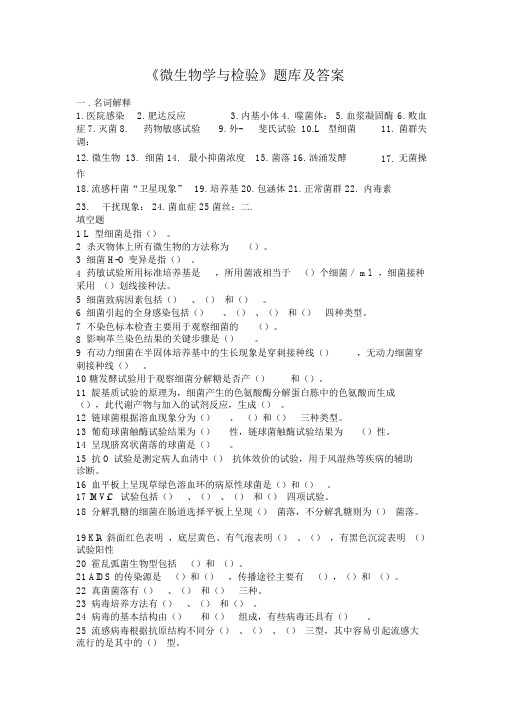
《微生物学与检验》题库及答案一 . 名词解释1. 医院感染2. 肥达反应3. 内基小体4. 噬菌体:5. 血浆凝固酶6. 败血症7. 灭菌8.药物敏感试验9. 外-斐氏试验 10.L 型细菌11.菌群失调:12. 微生物 13.细菌 14.最小抑菌浓度15. 菌落 16. 汹涌发酵17.无菌操作18.流感杆菌“卫星现象” 19. 培养基 20. 包涵体 21. 正常菌群 22. 内毒素23.干扰现象: 24. 菌血症 25 菌丝:二.填空题1 L 型细菌是指()。
2杀灭物体上所有微生物的方法称为()。
3细菌 H-O 变异是指()。
4药敏试验所用标准培养基是,所用菌液相当于()个细菌/ ml,细菌接种采用()划线接种法。
5细菌致病因素包括()、()和()。
6细菌引起的全身感染包括()、()、()和()四种类型。
7不染色标本检查主要用于观察细菌的()。
8影响革兰染色结果的关键步骤是()。
9有动力细菌在半固体培养基中的生长现象是穿刺接种线(),无动力细菌穿刺接种线()。
10 糖发酵试验用于观察细菌分解糖是否产()和()。
11靛基质试验的原理为,细菌产生的色氨酸酶分解蛋白胨中的色氨酸而生成(),此代谢产物与加入的试剂反应,生成()。
12链球菌根据溶血现象分为()、()和()三种类型。
13葡萄球菌触酶试验结果为()性,链球菌触酶试验结果为()性。
14呈现脐窝状菌落的球菌是()。
15抗 O 试验是测定病人血清中()抗体效价的试验,用于风湿热等疾病的辅助诊断。
16血平板上呈现草绿色溶血环的病原性球菌是()和()。
17IMViC 试验包括()、()、()和()四项试验。
18分解乳糖的细菌在肠道选择平板上呈现()菌落,不分解乳糖则为()菌落。
19KIA 斜面红色表明,底层黄色、有气泡表明()、(),有黑色沉淀表明()试验阳性20霍乱弧菌生物型包括()和()。
21AIDS 的传染源是()和(),传播途径主要有(),()和()。
微生物学检验练习题及答案
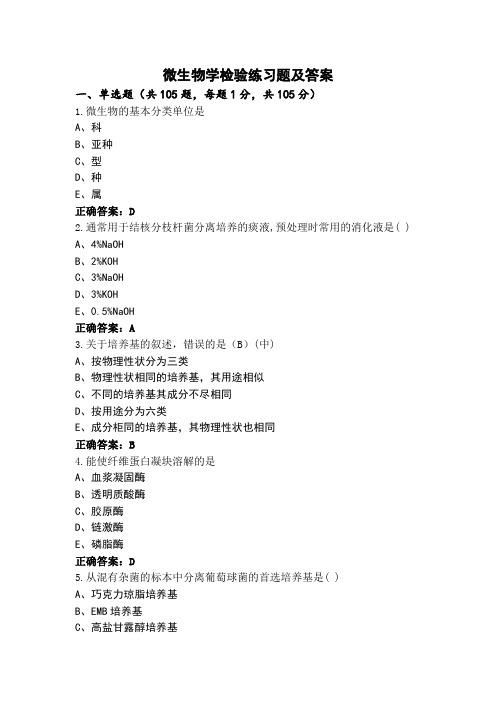
微生物学检验练习题及答案一、单选题(共105题,每题1分,共105分)1.微生物的基本分类单位是A、科B、亚种C、型D、种E、属正确答案:D2.通常用于结核分枝杆菌分离培养的痰液,预处理时常用的消化液是( )A、4%NaOHB、2%KOHC、3%NaOHD、3%KOHE、0.5%NaOH正确答案:A3.关于培养基的叙述,错误的是(B)(中)A、按物理性状分为三类B、物理性状相同的培养基,其用途相似C、不同的培养基其成分不尽相同D、按用途分为六类E、成分柜同的培养基,其物理性状也相同正确答案:B4.能使纤维蛋白凝块溶解的是A、血浆凝固酶B、透明质酸酶C、胶原酶D、链激酶E、磷脂酶正确答案:D5.从混有杂菌的标本中分离葡萄球菌的首选培养基是( )A、巧克力琼脂培养基B、EMB培养基C、高盐甘露醇培养基D、卵黄双抗培养基E、卵黄甘露醇培养基正确答案:C6.具有粘附作用的细菌结构是( )A、性菌毛B、荚膜C、鞭毛D、普通菌毛E、芽胞正确答案:D7.长期使用广谱抗生素可引起A、败血症B、菌血症C、菌群失调症D、毒血症E、脓毒血症正确答案:C8.有关培养基质量检查,叙述错误的是(A)(中)A、质量检查主要进行效果检定B、质量检查是在培养基使用前必须进行的C、进行质量检查的培养基是随机抽取的D、效果检定所用细菌须是已知的阳性或阴性标准菌株E、质量检查的目的是为了保证试验结果的可靠性正确答案:A9.利于细菌在体内扩散的物质是( )A、透明质酸酶B、M蛋白C、血浆凝固酶D、杀白细胞素E、菌毛正确答案:A10.关于尿素酶试验,叙述错误的是( )A、是一种氨基酸代谢试验B、常用尿素培养基C、分解底物是尿素D、阳性时培养基变酸性E、是肠道杆菌科细菌鉴定时常用试验正确答案:D11.下列为合成培养基的是(E)(中)A、SS培养基B、麦康凯培养基C、肉汤培养基D、血琼脂平板E、枸橼酸盐培养基正确答案:E12.长期使用广谱抗菌药物可以引起A、菌血症B、败血症C、毒血症D、脓毒血症E、菌群失调症正确答案:E13.真菌的繁殖结构就是:( )A、芽孢B、始体C、包涵体D、原体E、孢子正确答案:E14.下列培养基中不属于选择培养基的是(B)(中)A、SS培养基B、庖肉培养基C、EMB培养基D、高盐培养基E、罗一琴培养基正确答案:B15.下列描述的微生物特征中,哪项不是微生物的共同特征A、个体微小B、结构简单C、繁殖迅速D、分布广泛E、专性寄生正确答案:E16.利于细菌在体内扩散的物质是(C)(中)A、菌毛B、荚膜C、透明质酸酶D、血浆凝固酶E、M蛋白正确答案:C17.葡萄球菌A 蛋白(SPA)能与(C)(难)A、IgA 结合B、IgG 的Fab 段结合C、IgG 的FC 段结合D、lgG 的Fabl 段结合E、IgM 结合正确答案:C18.哪项不属细菌L 型的特征(B)(中)A、用高渗培养基分离B、细菌的休眠状态C、型菌落为“油煎蛋”样D、有致病性E、兰染色阴性,呈多形性正确答案:B19.TCBS培养基中使指示剂变色的物质是( )A、枸橼酸盐B、乳糖C、蔗糖D、半乳糖E、硫代硫酸盐正确答案:C20.甲基红试验中培养基的pH需降至多少,指示剂才指示阳性结果(C)(难)A、2.5B、5.OC、4.5D、6.5E、7.4正确答案:C21.通常临床微生物实验室属生物安全几级实验室A、BSL-1B、BSL-2C、BSL-3D、BSL-4E、BSL-5正确答案:B22.ONPG试验是测定细菌的(B)(中)A、乳糖酶B、β一半乳糖苷酶C、乳糖渗透酶D、B一半乳糖苷渗透酶E、蔗糖酶正确答案:B23.下列不能作为微生物危害评价的依据的是A、特定的病原体是否存在于国内B、当地是否能进行有效的预防或治疗C、病原微生物的传播途径D、暴露的潜在后果E、病原微生物的致病性和感染量正确答案:A24.克拉维酸属于何类药物A、喹诺酮类抗菌药物B、β-内酰胺酶抑制剂C、磺胺类抗菌药物D、氨基糖苷类抗菌药物E、β-内酰胺类抗菌药物正确答案:B25.均为革兰阳性杆菌的是( )A、结核分枝杆菌,鼠疫耶尔森菌,蜡祥芽胞杆菌B、枯草芽胞杆菌,产气肠杆菌,产单核细胞李斯特菌C、产气荚膜梭菌,百日咳鲍特杆菌,白喉棒状杆菌D、红斑丹毒丝菌,蜡样芽胞杆菌,铜绿假单胞菌E、白喉棒状杆菌,炭疽芽胞杆菌,产单核细胞李斯特菌正确答案:E26.属于区分葡萄球菌属和链球菌属的试验的是(E)(易)A、VP试验。
微生物学实验试题及答案
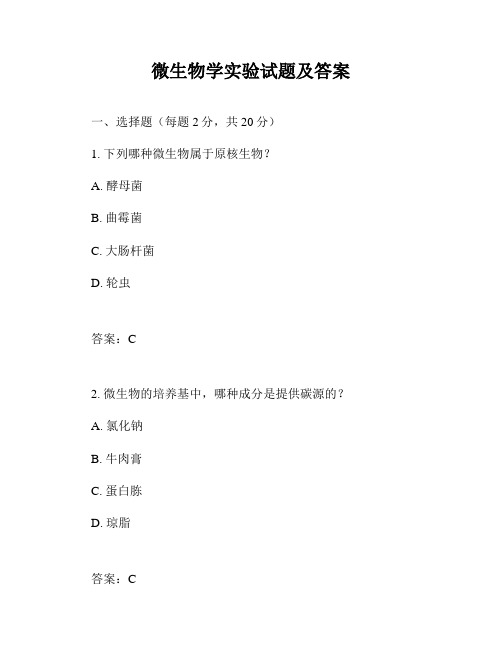
微生物学实验试题及答案一、选择题(每题2分,共20分)1. 下列哪种微生物属于原核生物?A. 酵母菌B. 曲霉菌C. 大肠杆菌D. 轮虫答案:C2. 微生物的培养基中,哪种成分是提供碳源的?A. 氯化钠B. 牛肉膏C. 蛋白胨D. 琼脂答案:C3. 微生物学实验中常用的染色方法不包括以下哪种?A. 革兰氏染色B. 酸性染色C. 碱性染色D. 荧光染色答案:C4. 以下哪种微生物是厌氧性的?A. 大肠杆菌B. 酵母菌C. 乳酸菌D. 金黄色葡萄球菌答案:C5. 微生物学实验中,用于检测大肠杆菌的培养基是?A. 牛肉膏蛋白胨培养基B. 血琼脂培养基C. 选择性培养基D. 营养琼脂培养基答案:C6. 微生物学实验中,用于分离和纯化微生物的方法是?A. 稀释涂布法B. 混合培养法C. 共培养法D. 连续培养法答案:A7. 微生物学实验中,用于测定微生物数量的方法是?A. 显微镜直接计数法B. 比浊法C. 滴定法D. 重量法答案:A8. 微生物学实验中,用于检测微生物生长繁殖的指标是?A. 菌落形成单位(CFU)B. 菌落总数C. 活菌计数D. 菌落直径答案:A9. 微生物学实验中,用于检测微生物代谢产物的方法是?A. 酶联免疫吸附测定(ELISA)B. 纸层析法C. 比色法D. 以上都是答案:D10. 微生物学实验中,用于检测微生物对抗生素敏感性的方法不包括?A. 纸片法B. 琼脂稀释法C. 肉汤稀释法D. 显微镜法答案:D二、填空题(每题2分,共20分)1. 微生物学实验中,常用的灭菌方法包括_______、_______和_______。
答案:干热灭菌、高压蒸汽灭菌、紫外线灭菌2. 微生物学实验中,常用的微生物分离方法包括_______、_______和_______。
答案:稀释涂布法、平板划线法、梯度稀释法3. 微生物学实验中,用于检测微生物生长繁殖的培养基类型包括_______、_______和_______。
微生物英文题库

Test 1: Development of Microbiology■Multiple Choice (choose one answer)1. The fundamental unit (基本单位)of all living organisms is the: C■.membrane■.cell■.nucleus■.cell wall2. Organisms that do not contain a true nucleus are referred to as:C■.fungi 真菌■.eukaryotic 真核生物■.prokaryotic 原核生物■.nankaryotic3. T he three kingdom classification system (三界分类系统)of organisms was proposed by:D■.Pasteur■.Bacon■.Winogradsky■.Woese4. Fungi differ from bacteria in a number of characteristics. The cell walls in fungi are composedof , while the cell walls of bacteria are composed of peptidoglycan. A■.chitin 壳多糖■.phospholipid 磷脂■.protein 蛋白质■.glucosamine 葡糖胺5. The first microscopes were developed by: C■.Ehrlich■.Metchnikoff■.Leewenhoek■.Lister6. Control of microbial infections can be accomplished by chemical or immune mechanisms. The first report on the production of an antibiotic(抗生素)is credited to:C■.Lister■.Fleming■.Ehrlich■.Koch7. The term "antibiotic" means:C■.a substance produced by the laboratory that kills or inhibits other microorganisms■.a substance produced by microorganisms that kills or inhibits molds(霉菌)■.a substance produced by microorganism that kills or inhibits other microorganisms■.a substance produced by microorganisms that kills or inhibits cancer cells8. The first documented use of a vaccine(疫苗)for smallpox天花was reported by the English physician:D■.Lister■.Florey■.Fleming■.Jenner9. Active immunity (主动免疫)can be distinguished from passive immunity in that the former requires:B■.development of antibodies in one's own body by stimulation with external antibodies■.development of antibodies in one's own body by stimulation with external antigens(抗原)■.Flemingdevelopment of antibodies in a foreign host and transfer to one' s own body■.development of antigens in one's own body by stimulation with external antibodies10. The process of nitrification(硝化作用)by bacteria described by Winogradsky converts:A■.ammonia to nitrate ions 将氨转化成硝酸盐■.nitrate ions to ammonia 将硝酸盐转化成氨■.N2 to ammonia 将氮气转化成氨■.ammonia to urea 将氨转化成尿素11. The transfer of DNA from one organism to another through the use of a viral vector(病毒载体)is referred to as:B■.electroporation 电穿孔■.conjugation 接合生殖■.transformation 转化■.transduction 转导12. The genetic material of a bacteria is located in the molecule:B■.RNA■.DNA■.protein■.lipid■Fill in the Blank1. Organisms that contain a true nucleus are called__eukaryotic_____2. Bacteria do not have a true nucleus and are considered _____prokaryotic__3. Bacteria can be divided into two groups, the ___archeabacteria____and the ____eubacteria(真细菌)___.4.___anaerobes(厌氧菌)___ are organisms that can grow without using molecular oxygen.5. Microorganisms that can synthesize complex organic compounds from CO2:are called ___autotrophs_(自养菌)__.6. _photoautotrophs(光能自养生物)_____ are microorganisms that obtain their energy to synthesize organic compounds from light.7. _heterotroph_(异养菌)___ require organic compounds for growth.8. Organisms that survive only at very high temperatures are referred to as__thermophile_(适温性)___.9. _methanogen_(产甲烷菌)____ are organisms that produce methane(甲烷)from CO2.10. ___halophile_(好盐的)__organisms grow under conditions of high salinity.11. Eubacteria can exhibit a number of morphological shapes. Identify four: a._spherical or cocci_____ b._cylindrical or rod_____ c.__spirals____ d.___irregular__12. Fungi, algae and protozoa can be differentiated from bacteria by the following characteristic:___eukaryotic____ .13. Fungi have cell wall consisting of __chitin(壳多糖)_____.14. Viruses consist of _nucleic acid_____surrounded by a protein coat.15. The scientific method utilizes deductive reasoning(演绎推理)and observations or experiments to prove or disprove a _hypothesis_(假说)___.16. The theory _spontaneous generation______of held that living organisms could arise from nonliving matter.(非生命物质)17. The process used to reduce the number of viable organisms(活菌)by moderate heating is called:_pasteurization__(巴士消毒法)___ .18. The process of tyndallization(间歇灭菌法)uses repeated heating to eliminate or___sterilize (杀菌)____ microorganisms from solutions.19.An _antibiotic(抗生素)______is a substance produced by microorganisms that inhibits or kills other microorganisms.20. The process of stimulating the immune defenses of the body is referred to as__immunization_____.21. White blood cells that engulf(吞食)foreign particles(异物颗粒)are referred to as_phagocytes___(吞噬细胞)__.22. A substance in serum(免疫血清)that can neutralize(中和)foreign material is referred to as __antitoxin_(抗毒素)___or __antibody__(抗体)__.23. Cells infected with a virus produce a substance called __interfewn____ that inhibits viral replication.24. Avery, Colin and MacLeod first demonstrated that transformation of nonpathogenic(非病原的)to pathogenic strains (致病菌株)of bacteria could be carried out by the transfer of ___DNA___.25. Exchange of genetic information by direct contact is referred to as__conjugation____.26. _transformation_(转化)____ is the process in which DNA is transferred from one bacteria to another.■Matchingl. Francis Bacon a. phagocytosis 吞噬作用2. Anton Leeuwenhoek b. antibody 抗体3. Paul Ehrlich c. nitrification 硝化作用4. Hans Gram d. immunization 免疫法5. Louis Pasteur e. three kingdom classification based on rRNA6. Robert Koch f. structure of DNA7. Joseph Lister g. first microscope 第一台显微镜8. Alexander Fleming h. conjugation or transduction 接合和转导作用9. Edward Jenner i. differential stain for bacteria10. Eli Metchnikoff j. interferon 干扰素11. Emil von Behring k. rabies vaccine 狂犬病疫苗12. Alick Isaac 1. penicillin 青霉素13. Sergei Winogradsky m. antiseptic(防腐剂)technique14. Joshua Lederberg n. established that bacteria can cause disease15. Watson and Crick o. magic bullet16. Carl Woese p. scientific method1.p2.g3.o4.i5.k6.n7.m8.l9.d 10.a 11.b 12.j13.c 14.h 15.f 16.eTest 2: Methods for Studying Microorganisms■Multiple Choice (choose one answer)1. Light microscopy (光学显微镜术)is dependent on the interaction of light with on object. The ability of light to pass through an object is referred to as:B■.transported light■.transmitted light 透射光■.reflected light 反射光■.refracted light 折射光2. The resolving power (R)(分辨率)of a microscope is dependent on the wavelength(波长)of light (;~) and the numerical aperture (NA) of the lens. The formula (公式)for R is: B ■.R = 0.5~. xNA■.R = 0.5;~/NA■.R = NA/0.5Jr■.R = Square root of 0.5)./NA?3. The gram stain(革兰氏染色)uses ~ as a mordant(媒染剂)to fix the primary stain:A ■.iodine 碘■.alcohol 乙醇■.acetone 丙酮■.safranin 番红4. The acid-fast stain (抗酸性染色)is useful in the identification of which of the following organisms:C■.Staphylococcus aureus 金黄色葡萄球菌■.Mycoplasma mycoides 霉菌样支原体■.Mycobacteria tuberculosis 结核分枝杆菌■.Moraxella osloensis 奥斯陆摩拉克菌,5. Botulism(肉毒中毒)is a serious disease that can develop from the improper cooking of food containing bacterial spores(孢子). Which of the following genera (属)are capable of producing spores?D■.Salmonella 沙门氏菌属■.Listeria 利斯塔氏菌属■.Escherichia 埃希氏菌属■.Clostridia 梭菌属6. Which of the following types of microscopes utilizes electron beams (电子束)to visualize (使可见)objects?B■.Nomarski■.TEM 投射型电子显微镜■.PCM 脉冲■.Confocal 共焦的7. A mixture of organisms was isolated from a patient suspected of having "Strep Throat." (脓毒性咽喉炎)Which type of media would you use to isolate the suspected pathogen(病原体)? D ■.defined■.enriched■.selective■.differential8. Sterilization(灭菌)of material with an autoclave(高压灭菌锅)utilizes steam to kill microorganisms. The correct procedure for sterilization with an autoclave is:A■.15 min at 121℃at 15 lb/in2■.15 min at 256℃at 15 lb/in2■.15 min at 121℃at 1 lb/in2■.15 rain at 121℃at 30 lb/in29. An antibiotic was added to a culture of bacteria to determine its effect. What method of enumeration would you use to determine the efficacy of the antibiotic? B■.direct count 直接计数■.viable count 活菌数■.turbidimetric count 浊度计数■.absorbance 吸光度10. Identification of microorganisms(微生物)can be accomplished(完成)by a number of techniques. Which of the following requires the growth of the organism?C■.enzyme linked assay(含量测定)■.gene probe 基因探针■.metabolic 代谢■.fluorescent 荧光■Fill in the Blank1. A media (培养基)where all the ingredients(成分)are known is called a _defined_____media.2. __aseptic(无菌的)____technique is used to maintain a pure culture(纯培养物)and avoid contamination.(污染)3. Sterilization instrument(灭菌器械)that utilizes steam under pressure: _autoclave_(高压灭菌锅)_____.4.A___streak___ plate utilizes a loop(接种环)or needle(接种针)to distribute and isolate colonies on a culture plate.(培养皿)5.__serological(血清学的)____ identification utilizes antibodies(抗体)for naming of bacterial species.6. Bacteria can be preserved(保藏)for long periods of time by freeze-drying(冷冻干燥)or__lyophilization____(冻干保藏法).7. The mrbidimetric method of counting bacteria utilizes a _spectrophotometer(分光光度计)_____ to measure the amount of light passing through a solution.8. The viable plate(平板细菌计数)count counts live bacterial colonies(菌落)in the range or____30__ to__300____ .9. A counting chamber(计数板)and a microscope (显微镜)are used in the_direct_____ count of bacteria.10. The _gene probe_(基因探针)____technique utilizes a labeled(示踪的)complementary strand of nucleic acid to identify specific bacteria in a specimen.(样本)■MatchingMatching I:l. Primary stain for gram stain a. Negative stain 负染色2. Stains bacterial cell b. Carbohl fuchsin 品红3. Used to fix stain c. Crystal violet 结晶紫4. Decolorize脱色 d. Malachite green 孔雀绿5. Spore stain e. Safranin 番红6. Acid-fast stain f. Positive stain 正染7. Gram- bacteria take up this counterstain g. Alcohol 乙醇8. Stains background h. Mordant 媒染剂Matching II:1. Media used to inhibit growth of unwanted organisms a. Enrichment 富集2. Media where all components are not known b. Selective 选择性的3. Media used to contrast organisms on same plate c. Differential4. Media used to enhance growth d. ComplexMatching I:1.c2.f.3.h4.g5.d.6. b7.e8.aMatching II:1.b2.d3.c4.aTest 3: Organization and Structure of Microorganisms■Multiple Choice (choose one answer)1. Eukaryotic membranes can be differentiated from prokaryotic membranes because eukaryotic membranes contain____as part of the lipid(脂质)component of the membrane. D ■.phosphates 磷酸盐类■.fatty acids 脂肪酸类■.proteins 蛋白类■.sterols 甾醇类2. The arrangement of proteins and lipids in the membrane is referred to as the:B■.bilayer model 双层膜模型■.fluid mosaic model 流动镶嵌模型■.trilayer model■.permeable(有渗透性的)model3. The movement of water molecules across the membrane in response to a concentration gradient is referred to as: B■.diffusion 扩散■.osmosis 渗透■.translocation 易位■.transport 运输4. The membrane of a cell is able to differentiate molecules that enter or exit the cell and act as a ____ barrier(屏障). C■.semipermanent 半永久性■.semitransparent 半透明的■.semipermeable 半渗透性的■.semidiffuse5. Movement of molecules at an enhanced rate across the membrane is called: A■.facilitated diffusion 易化扩散■.passive diffusion 被动扩散■.osmosis 渗透作用■.permeation6. Which of the following mechanisms transports molecules without chemical alteration? A■.active transport 主动运输■.group translocation基团转位■.facilitated diffusion易化扩散■.binding protein transport 蛋白质转运7. Which of the following transport mechanism occurs only in Gram-negative bacteria?D■.active transport 主动运输■.group translocation 基团转位■.facilitated diffusion 易化扩散■.binding protein transport蛋白质转运8. Which of the following transport mechanisms occurs only in prokaryotes? B■.active transport■.group translocation■.facilitated diffusion■.binding protein transport9. Lysozyme(溶菌酶)and penicillin (青霉素)have activity against the cell wall. Lysozyme breaks this component;penicillin prevents its formation. C■.lipopolysaccharide 脂多糖■.phospholipid 磷脂■.peptidoglycan 肽聚糖■.teichoic acid 磷壁酸10. Partial destruction of the cell wall with lysozyme leaves a cell called a: B■.protoplast 原生质体■.spheroplast 原生质球■.periplast 周质体■.capsule 荚膜11. A capsule(荚膜)can be differentiated from a slime layers(粘液层)since the capsule: D■.is made up of complex carbohydrates(复合糖)and the slime layer contains protein ■.is bound to the cell membrane■.is bound to the cell wall■.is bound to the outer membrane12. The chromatin of eukaryotic cells is composed of DNA and____ A■.histone proteins 组蛋白■.non histone proteins■.RNA■.ribosomes13. DNA transfers information to make proteins in molecules referred to as:B■.iRNA■.mRNA■.rRNA■.tRNA14. Mitochondrial ribosomes (线粒体核糖体)are____in size. C■.40S■.60S■.70S■.80S15. The process whereby ATP is generated by the flow of protons (质子)across a membrane is: B■.substrate level phosphorylation 底物水平磷酸化■.chemiosmosis 化学渗透作用■.protokinesis■.glycolysis 糖酵解16. The endoplasmic reticulum (ER)(内质网)is a membranous structure within eukaryotic cells. It is the site for protein synthesis and for storage and transportation of molecules out of the cell. Which part of the ER is used for protein synthesis? B■.golgi apparatus 高尔基体■.rough ER 粗面内质网■.smooth ER 光面内质网■.microbody 微体17. Flagella of bacteria are composed of protein subunits called flagellin(鞭毛蛋白); eukaryotic flagella are composed of subunits called: D■.flagellin鞭毛蛋白■.cilin■.spectrin 血影蛋白■.tubulin 微管蛋白18. Flagella(鞭毛)are used to propel the cell in response to an environmental signal. Bacterial flagella and eukaryotic flagella can be differentiated since the former moves by:A ■.rotating around its base■.pulling itself once it is attached to a surface or mate■.waving or whipping to move the cell■.twisting and releasing similar to a rubber band19. Endospores(内生孢子)are multilayered structures that provide protection from environmental stress and are composed of: B■.peptidoglycan(肽聚糖)and lipopolysaccharide (脂多糖)■.peptidoglycan and calcium dipicolonate■.peptidoglycan and calcium bicarbonate碳酸脂■.lipopolysaccharide and succinic acid (琥珀酸)20. Gram-positive bacteria can be differentiated from Gram-negative bacteria since the peptidoglycan (肽聚糖)layer of later comprises____% of the cell wall. D■.90■.50■.30■.10■Fill in the Blank1. Most cells use energy in the form of__ATP____ to run the cell.2. Phospholipids(磷脂类)of eubacterial cells are composed of a __phosphate (磷酸盐)____group and a _fatty acid____on a glycerol(甘油)backbone.3. Membrane proteins found on the surface are called __peripheral(次要的)____ proteins.4.The energy source for active transport in eukaryotes is derived from ATP.The energy for active transport in prokaryotes is derived from __protomotive force____.5. The region between the outermembrane in Gram-negative(革兰阴性)bacteria and the cell wall is called the ___periplasmic space_(壁膜间隙)___.6. Extrachromosomal(染色体外的)DNA elements found in bacteria are called____plasmids____.7. Ribosomes are structures composed of ____proteins___ and ____rRNA__.8. The fluid inside a cell is referred to as the ___cytoplasm_____.9.The hereditary organelle (具遗传效应的细胞器)of eukaryotic cells is called the __nucleus____.10. The process by which a cell engulfs(吞食)and internalizes(陷入)particles such as bacteria or other cells is called ____phagocytosis_(吞噬作用)_.■Matchingl. Prokaryotes原核生物 a. hook and basal body2. Eukaryotes真核生物 b. end of cell3. hydrophobic 疏水的 c. microtubles4. Hydrophilic亲水的 d. pill5. Permease通透酶 e. eukaryotes6. eubacteria 真细菌 f. surrounding cell7. Archeobacteria古细菌g. 9 + 2 arrangement8. cellulose 纤维素h. prokaryotes9. chitin 几丁质i. fatty acid10. circular chromosome 环状染色体j. algae11.linear chromosome线状染色体k. transport protein12. 70 S ribosomes 1. lack organelles无细胞器13. 80 S ribosomes m. posses nucleus14. Polar(两极的)flagella n. water loving 亲水性15. Peritrichous(周围的)flagella o. fungi 真菌16.bacterial flagella p. L-amino acids17. eukaryotic flagella q. D-amino acids18. fimbria 菌毛19. cilia 纤毛20. cytoskeleton 细胞骨架1.l2.m,j,o3.n4.i5.k6.p7.q8.j9.o 10.h 11.e,j,o 12.h,j,o13.e 14.b 15.f 16.a17.g 18.d 19.e 20.cTest 4 : Prokaryotes■Genus Match: (Match the Genus with the Appropriate Group)Match the Genus with the Appropriate Group:l. Spirochete 螺旋体 a. Halococcus 噬盐球菌属2.Gm- aerobic(好氧的), motile, vibroid b. Clostridium 梭菌属3.3. Gm- aerobic cocci (球菌) c. VeiUonella4.Gm- facultative (兼性的)rod (杆状) d. Caulobacter 柄杆菌属5.5. Gm- anerobic(厌氧的)rod e. Treponema 密螺旋体6. Gm- anaerobic cocci f. Myxococcus 粘球菌7. Budding(芽殖)/appendaged g. Streptococcus 链球菌8. Fruiting body子实体h. Pyrobaculum 热棒菌属9. Gm+ cocci i. Campylobacter 弯曲杆菌10. Gm+ rods (no spores) j. Methanococcus 产甲烷球菌11. Gm+ rods (endospores内孢子) k. Listeria 李斯特菌属12. Gm+ irregular rod 1. Bacteroides 拟杆菌属13. Halophile 喜盐生物m. Neisseria 奈瑟氏菌14. Thermophile 噬热生物n. Salmonella 沙门氏菌15. Methanogen 产烷生物o. Corynebacteria 棒状杆菌l.e 2.I 3.m4.n5.16.c7.d 8.d 9.g10.k 11.b 12.o13.a 14.h 15.j■Characteristic Match: (Match the Characteristic with the Appropriate Genus or Group)Match the Characteristic with the Appropriate Genus or Group:l. Borrelia 包柔氏螺旋体 a. sulfur reducing 硫降低2. Helicobacter 螺杆菌 b. acid fast 耐酸的3. Shigella 志贺氏杆菌 c. Gm+ rod(杆状), aerobic(需氧),endospores (内孢子)4.Desulfovibrio 硫磷弧菌属 d. gliding 滑动5. Chlamydia 衣原体 e. psedomurein6. Anabaena 鱼腥藻 f. cyanobacteria 蓝藻细菌7. Chemolithotrophic无机化能营g. Helical(螺旋形)rod, no central fibrils (中央纤维)8. Caulobacter 柄杆菌属h. helical rod, central fibrils9. Cytophaga 纤维菌属i. filamentous 丝状的10. Staphylococcus葡萄球菌j. obligate intracellular parasite必须寄生在细胞的寄生虫11. Bacillus 芽孢杆菌k. Gm+ cocci in clusters12. Actimomycetes 1. Enterobacteriacea13. Mycoplasma 支原体m. Nitrobacter 硝化杆菌属14. Mycobacteria 分枝杆菌n. prosthecae 菌柄15. Methanogen 产甲烷菌o. fried egg1.h2.g3.14.a5.j6.f7.m 8.n 9.d10.k 11.c 12.f13.o 14.b 15.eTest 5: Eukaryotes■Multiple Choice (choose one answer)l. Fungi are considered heterotrophic(非自养的)because they obtain nutrition through: C ■. phagocytosis 吞噬作用■. endocytosis 内吞作用■. adsorption 吸附作用■. photosynthesis 光合作用2. The separation between filamentous(丝状的)fungal cells are referred to as:B■. cell walls■. septa 隔膜■. chitin 几丁质■. side walls 侧壁3. Fungi that can appear as a yeast or filamentous are referred to as:D■. Fungi imperfecti 半知菌纲■. Fungi perfecti■. cheterotrophic fungi■. dimorphic fungi4. Thick walled spores(厚壁孢子)formed within fungal cells are called:D■. Arthrospores分节孢子■. sporangiospores 包囊孢子■. blastospores 芽生孢子■. chlamydospores 后垣孢子5. Asexual fungal spores that are formed from fragmented hyphae(支离破碎的菌丝)are called:A■. arthrospores■. sporangiospores■. ascospores■. chlamydospores6. Asexual fungal spores formed within a sac-like structure are called:B■. arthrospores■. sporangiospores■. blastospores■. ascospores7. Sexual fungal spores(孢子)formed within a sac-like structure are called:D■. Chlamydospores厚垣孢子■. sporangiospores 包囊孢子■. blastospores 芽孢子■. ascospores 子囊孢子8. Which of the following classes of fungi cause hypertrophy (肥大)of cells similar to the bacterium A. tumifaciens?C■. Oomycetes■. Ascomycetes■. Chytridiomycetes■. Deuteromycetes9. Which of the following fungi are motile by two flagella(鞭毛)? A■. Oomycetes 卵菌■. Ascomycetes 子囊菌■. Chytridiomycetes 壶菌纲■. Deuteromycetes 半知菌纲10. Common bread mold(发霉)is caused by Rhizopus stolonifer匍枝根霉which is a: D■. Deuteromycete■. Ascomycete■. Basidiomycete■. Zygomycete11. Ascomycetes子囊菌can be differentiated from zygomycetes 接合菌since the ascomycetes have hyphae菌丝.B■. septated 有隔膜■. aseptated 无隔膜12. Which of the following fungi have a sexual reproductive phase? B■. Coccidiodes 球孢子菌■. Histoplasma 组织浆胞菌■. Aspergillus 曲霉■. Alternaria 链格孢属13. Which class of fungi do not have a sexual reproductive phase(有性生殖阶段)? A■. Deuteromycete 半知菌■. Ascomycete 子囊菌■. Basidiomycete 担子菌■. Zygomycete 结合菌14. The cell structures of bracket(多孔菌)fungi are referred to as: A■. Septa隔膜■. basidiocarp 担子果■. anteridium■. Zygomycet15. The toxin (毒素)from which of the following mushrooms inhibits polymerase activity(聚合酶活性)?A■. Agaricus bisporous■. Ischnorderma resinosum■. anteridium■. Zygomycet16. The common mushroom(蘑菇)belongs to which group of fungi? B■. Ascomycetes 子囊菌纲■. Basidiomycetes 担子菌纲■. Chytridiomycetes 壶菌纲■. Deuteromycetes 半知菌纲17. Which of the following Deuteromycetes(半知菌)are often colored green and the conidiospores(分生孢子)are arranged in a brush shape?A■. Penicillium 青霉菌■. Alternaria 链格孢属■. Coccidiodes 球孢子菌■. Geotrichum 地霉菌属18. All of the following algae are green with the exception of D■. Euglena 裸藻■. Volvox 团藻■. Spirogyra 绿藻■. Nemalion19. Which algae contain a red pigmented area known as the eyespot?(眼点) B■. Euglenoids■. Chlorophycophyta■. Rhodophycophyta■. Phaeophycophyta20. The outer layer of Euglena(裸藻)is called: C■. cell wall■. fmstule■. pellicle 菌膜■. blade21. Xanthophyll pigments give algae a color. C■. red■. blue■. yellow■. green22. Which of the following algae are closer phylogenetically(系统发育)to higher plants(高等植物)? C■. brown algae■. yellow-green algae■. red algae■. green algae23. The storage material, paramylon, is made in which of the following groups of algae(藻类)?A■. euglenoid 眼虫藻■. red algae 红藻■. green algae 绿藻■. brown algae 褐藻24. The mouth of a ciliated protozoa(有纤毛的原生动物)is called a: B■. Phagosome吞噬体■. cytosome 胞质体■. lysosome 溶酶体■. porosome25. Sarcodina (肉足纲)are protozoa that are propelled (推进)by:B■. flagella■. cilia■. pseudopodia■. they are technically nonmotile26. Trypanosomes(椎体虫)belong to which group of protozoa: A■. pseudopodia formers■. ciliates■. spore formers27. Plasmodium 疟原虫is grouped as a:D■. flagellates■. pseudopodia formers■. ciliates■. spore formers28. The mature form of spore (孢子)forming protozoa (原生动物)are called: C■. protozoites■. sporozoites■. trophozoites■. cytozoite29. Paramecium (草履虫)are classified as: C■. Flagellates鞭毛虫类■. pseudopodia(伪足)formers■. ciliates 纤毛虫类■. spore formers 芽孢菌30. The resting stage of a protozoa (原生动物)are called:D■. Trophozoites营养体■. sporozoites 孢子体■. saprozoites 腐生动物■. cysts 囊肿■Fill in the Blank1. Unicellular fungi are called __yeasts____.2. Filamentous fungi form branching structures called _hyphae_____.3. The most common form of reproduction in yeasts occurs by __budding____.4.Silica is found in the cell wall of __diatoms____.5. The external structures of mushrooms are referred to as ___fruiting_bodies_.6. The growth of fungi can be expressed by (_measuring the increase in the mass of the fungus____).7. Red tide is caused by a toxin released by the organism, Gonyaulax, which belongs to the __fire algae____ group of fungi.8. Agar is made from this group of algae: __brown algae____.9.Trypanosoma gambiense causes the disease __African sleeping sickness____.10. A flagellate protozoa that can be found in mountain streams and causes diarrhea is __Giardia____.Test 6: Bacterial Growth and Reproduction■Multiple Choice (choose one answer)1.In bacterial cultures, growth can be demonstrated by an increase in: C■.mass■.cell size■.cell number2.DNA replication in bacteria is controlled by: B■.cell size■.cell division 细胞分裂■.cell separation■.cell initiation3.During which phase of bacterial growth is there an increase in cell size but not in cell number? A■.lag 滞后■.log 对数■.stationary 稳定期■.exponential 指数期4. The generation time(寿命)for bacteria is determined by: D■.measuring the time it takes to double the number of bacteria from the time the culture (培养)was initiated until the beginning of stationary phase 稳定期■.measuring the time it takes to double the number of bacteria from lag phase(迟滞期)to death phase衰亡期■.measuring the time it takes to double the number of bacteria from log phase to the end of stationary phase■.measuring the time it takes to double the number of bacteria from log phase to the beginning of stationary phase5. Most pathogenic bacteria(致病菌)are considered: B■.psychrophiles 嗜冷微生物■.mesophiles 嗜温微生物■.thermophiles 嗜熱菌■.merophiles6. Bacteria that grow at low nutrient concentrations(营养浓度)are referred to as:D■.autotrophs 自养生物■.phototrophs 光合自养微生物■.copiotrophs■.oligotrophs7. In times of nutrient deficiencies(营养不足), the bacteria Clostridium(芽孢杆菌)produce____until conditions are permissive for vegetative growth.(营养生长)B ■.prosthecae 菌柄■.spores 芽孢■.stalks 茎杆■.fruiting bodies 子实体8. The temperature of the incubator(恒温箱)was raised from 15~(2 to 35~(2. The cultures(培养物)in the incubator demonstrated a____fold increase in enzymatic(酶活性)activity. B ■.two■.four■.eight■.twenty9. Organisms that grow at or near their optimal(最佳的)growth temperature are called:B■.stenothermal(狭温性的)bacteria■.euthermal bacteria■.cauldoactive bacteria■.mesophilic bacteria 嗜常温菌10. All of the following are toxic oxygen products(有毒氧化产物)except: D■.02■.OH-■.H20■.H20211.Catalase(过氧化氢酶), which is produced by Staphylococci(葡萄球菌), catalyzes(催化)which of the following reactions?C■.202+ 2H+ →2H202 + 02■.2H202→2H20 + 02■.H202 + NADH + H+→2H20 + NAD■.H202 + e- + H+→H2O + OH-12. A saturated solution(饱和溶液)of NaC1 has a water activity index of:C■.1.0■.0.90■.0.80■.0.7013. Organisms that can grow at a water index(指数,标准)at or below that of NaCI are called:A■.xero tolerant 耐旱的■.salt tolerant 耐盐的■.meso tolerant■.salo tolerant14. All of the following organisms will survive an environment of 0.9 Aw(水分活度)except: D■.Lactobacillus 乳酸菌■.Staphylococcus 葡萄球菌■.Saccharomyces 酵母菌■.SpiriUum15. Halophiles (嗜盐微生物)are classified as organisms that require ____for growth. B■.sugar■.salt■.water■.air16. Osmophiles (嗜高渗菌)require a ____Aw水分活度for growth. B■.low■.high17. The pressure exerted on a cell due to high solute concentrations is referred to as:A■.osmotic pressure 渗透压■.hydrostatic pressure 液体静压力■.barometric pressure 气压■.surface tension 表面张力18. A diver encountered a new bacterial isolate while she was diving at 1000 m. The organism will be classified (归类为)as: D■.marine■.barotolerant■.barophilic 适压的■.normal19. Fungi can be differentiated from most bacteria by culturing(培养)at:B■.marine 海洋■.low pH■.neutral pH20. All phototacfic bacteria respond to light by: D■.moving away from the source of light 远离光源■.moving toward the source of light 向光源移动■.increasing the movement of their flagella 增加鞭毛■.creating gas vesicles to rise to the surface 产生气泡浮出水面■Fill in the Blank1. Organisms that grow best above 40oC are called__thermophile____.2. Organisms that grow best below 20oC are called___psychrophile___.3. Organisms that grow best between 20 and 40oC are called _mesophile_____.4.Myxobacteria form unique structures called _fruiting body_____ to cope with nutrient deficiencies.5. Bacteria that grow only at reduced oxygen concentrations are called __obligate anaerobe_____.6. Bacteria that require oxygen for growth are called__obligate aerobe___.7. Bacteria that grow at high nutrient concentrations are called __copiotroph____.8. Caulobacter is an example of a _stalked_____ bacteria.9.At temperatures above the optimum, E. coli and other bacteria induce a change in gene expression called___heat shock response___.10. A change in hydrostatic pressure of 10 atm is experience with an increase in depth of ___100___ m.■MatchingCell Cycle Matching:l. C a. cell enlargement2. M b. condensation of chromosomes 染色质的浓缩3. G1 c. replication of the genome 基因组的复制4. G2 d. separation of chromosomes 染色体的分离5. S e. cell division 细胞分裂1.e2.d3.a4.b5.cTest 7: Control of Microbial Growth■Multiple Choice (choose one answer)1.Chemicals used on the body to control microorganisms are called:A(使用于尸体上用以抑制细菌生长的化学物质被称为)■.antiseptics 防腐剂■.disinfectants 消毒剂■.antibiotics 抗生素。
- 1、下载文档前请自行甄别文档内容的完整性,平台不提供额外的编辑、内容补充、找答案等附加服务。
- 2、"仅部分预览"的文档,不可在线预览部分如存在完整性等问题,可反馈申请退款(可完整预览的文档不适用该条件!)。
- 3、如文档侵犯您的权益,请联系客服反馈,我们会尽快为您处理(人工客服工作时间:9:00-18:30)。
《微生物学》实验双语测试题《Experiment for microbiology》test1.Multiple Choice (choose one answer)(每小题2分,共20分)1.The first microscopes were developed by:A.EhrlichB.MetchnikoffC.LeewenhoekD.Lister2.Light microscopy is dependent on the interaction of light with on object. The ability of light to pass through an object is referred to as:A.transported lightB.transmitted lightC.reflected lightD.refracted light3.The resolving power (R) of a microscope is dependent on the wavelength of light (;~) and the numerical aperture (NA) of the lens. The formula for R is:A.R = 0.5~. xNAB.R = 0.5;~/NAC.R = NA/0.5JrD.R = Square root of 0.5)./NA4.The gram stain uses ~ as a mordant to fix the primary stain:A.iodineB.alcoholC.acetoneD.safranin5.The acid-fast stain is useful in the identification of which of the following organisms:A.Staphylococcus aureusB.Mycoplasma mycoidesC.Mycobacteria tuberculosisD.Moraxella osloensis6.Which of the following types of microscopes utilizes electron beams to visualize objects?A.NomarskiB.TEMC.PCMD.Confocal7.Sterilization of material with an autoclave utilizes steam to kill microorganisms. The correct procedure for sterilization with an autoclave is:A.15 min at 121℃at 15 lb/in2B.15 min at 256℃at 15 lb/in2C.15 min at 121℃at 1 lb/in2D.15 rain at 121℃at 30 lb/in28.An antibiotic was added to a culture of bacteria to determine its effect. What method ofenumeration would you use to determine the efficacy of the antibiotic?A.direct countB.viable countC.turbidimetric countD.absorbance9.The transfer of DNA from one organism to another through the use of a viral vector is referred to as:A.electroporationB.conjugationC.transformationD.transduction10. In bacterial cultures, growth can be demonstrated by an increase in:A.massB.cell sizeC.cell numberD.cell length得分评卷人2.Fill in the Blank(每小题1分,共20分)1. The structure of the bright-field microscopeFig 1 Bight-field microscope1. Ocular lens.2. Tube.3. Nosepiece.4. Objective lens.5. Stage.6. Condenser lens.7. Iris diaphragm.8. Reflector.9. Arm. 10. Stage adjustment knob. 11. Condenser adjustment knob. 12. Fine-adjustment knob. 13.Coarse-adjustment knob. 14. Base.2. IMViC Series include 15.Indole production、16.The Methyl Red Test、17.The Voges-Proskauer Test、18.Citrate Utilization3. Pasteurization Inoculate Bacillus subtilis and Escherichia coli respectively to nutrient broth, place the tubes to a 63℃water bath for 30 minutes.得分评卷人3.Matching(每小题2分,共24分)Matching I:l. Primary stain for gram stain a. Negative stain2. Stains bacterial cell b. Carbohl fuchsin3. Used to fix stain c. Crystal violet4. Decolorize d. Malachite green5. Spore stain e. Safranin6. Acid-fast stain f. Positive stain7. Gram- bacteria take up this counterstain g. Alcohol8. Stains background h. Mordant1.c2.f.3.h4.g5.d.6. b7.e8.aMatching II:1. Media used to inhibit growth of unwanted organisms a. Enrichment2. Media where all components are not known b. Selective3. Media used to contrast organisms on same plate c. Differential4. Media used to enhance growth d. Complex1.b2.d3.c4.a得分评卷人4.Discussion(每小题12分,共36分)1. What’s the principle of Gram stain?A: Gram stain is a popular compound staining technique and differential staining processes are required by the use of crystal violet, Gram’s iodine, 95% ethyl alcohol, and safranin sequentially. It divides bacterial cells into two major groups named gram positive (G ) and gram negative (G-), which makes it an essential tool for classification and differentiation of microorganisms. According to Gram stain, Gram positive bacteria bind crystal violet, couldn’t be decolorized by 95% ethyl alcohol, and appear violet, while Gram negative bacteria are decolorized by 95% ethyl alcohol, bind safranin , and appear red.Generally, the principle of gram stain are as follows. ①The isoelectric point of gram positive bacteria is lower (pI=2~3) than that of gram negative bacteria (pI=4~5). So it contains much more negative charge and bind to crystal violet tightly. ②The cell wall of gram negative bacteria is composed of outer membrane containing much lipid composition, which is sensitive to ethyl alcohol. When decolorizing with 95% ethyl alcohol, the complex of crystal violet and iodine is extracted from cell wall. ③The cell wall of gram positive bacteria contain less lipid composition that is not sensitive to ethyl alcohol decolorizing. In addition, it contains multiplayer of high percentage of peptidoglycan and teichoic acid with large amount of negative charges. The complex of crystal violet and iodine binds to cell wall tightly and can not be extracted by 95% ethyl alcohol. So it appear purple.2.What’s the difference of the mycelia and spore between antinomycetes and molds?A: The primary cell structure of antinomuycetes is similar to bacteria. Antinomycetes havefilament which contain substrate filament and aerial filament and sporebearing filament. Sporebearing filament differentiate to spore. The shape of sporebearing filament are sphere, ellipse and rod. The morphology and color of aerial filament and spore are important for the classification and characterization of antinomycetes.Molds are eukaryotic cells and most of them are multicellular and filamented. The filament of molds is often wider than that of antinomycetes. Spores have different shapes and are divided into asexual or sexual ones.The morphology of mycelia and spore for antinomycetes and molds can be observed by microscope and cultivated on concavity slide or cover slip.After inoculated on agar culture media and cultured at approximate temperature for some time, microorganisms grow to form colonies from single cell which can been seen by the naked eye. The characteristics of colonies depends on their cell structure and growth behavior which is further used to the identification of microorganisms.3.How to judge if a pharmaceutical preparation is qualified for microbial contaminations or not? A: According to the pharmacopoeia, drugs for external or oral use need microbial limitation check except for aseptic inspection. That is the number of bacteria and molds and yeast, the pathogenic bacteria such as Escherichia coli, Salmonella species, Staphylococcus aureus, Pseudomonas aeruginosa, Bacillus tetani and living mite.The microbial standards of drugs are as shown in Table 44.1. In addition, no Salmonella species should be checked in preparations from any animal organs. The number of molds in oral antibiotics should be controlled to be less than 100 CFU/g and bacteria in antifungi orals less than 100 CFU/g too. On the other hand, mildewed and mite contaminated drugs are not qualified. The number of bacteria and molds can be determined by agar plate. Pathogenic bacteria can be confirmed by its morphology biochemical tests while living mite is observed by microscope.The number of bacteria and molds in the plates is reported in the following way. At first, it is suitable for bacteria counting when there are 30 to 300 colonies in plates while 30 to 100 for molds.(1) When the number of colonies at one dilution series is among 30 to 300 for bacteria or 30 to 100 for molds, report it.(2) When the number of colonies at two dilution series is among 30 to 300 for bacteria or 30 to 100 for molds, calculate the ratio as follows:Where NH and NL are colonies of high and low dilution series respectively, DH、DL are dilution times for two dilution series respectively. When R≤2, the average number of two dilution series is reported and the number of low dilution series is reported for R>2.(3) When the average number of colonies at three dilution series is among 30 to 300 for bacteria or 30 to 100 for molds, report it based on the two of low dilution series.(4) When the average number of colonies at all dilution series is not in the range of 30 to 300 for bacteria or 30 to 100 for molds, report colonies number which is most close to the range above.(5) When the average number of colonies at all dilution series is more than 300 for bacteria or 100 for molds, report colonies number based on the highest dilution series.(6) When the average number of colonies at all dilution series is less than 30, report coloniesnumber based on the lowest dilution series.(7) When the average number of colonies at 1:10 or 1:100 dilution series is not less than colonies of drug or 1:10, media dilution determination should be used.。
